Earthen Plasters Stabilized through Sustainable Additives: An Experimental Campaign
Abstract
:1. Introduction
2. Materials and Methods
2.1. Materials
2.2. Samples Composition, Preparation, and Characteristics
| Samples ID | Additive | % by Weight of Additive * | % by Weight of Water |
|---|---|---|---|
| Earth | Not present | - | 28 |
| A | Slaked lime | 5 | 28 |
| B | Geopolymeric solution | 40 | ** |
| C | Enzymatic solution | 30.5 | ** |
| D | CKD | 5 | 36 |
| E | Plaster of Paris | 20 | 28 |
| F | Plaster of Paris | 5 | 28 |
2.3. Analytical Methods
2.3.1. Characterization of Raw Materials
2.3.2. Mineralogical Modification in Clay Fraction Reacting with Additives
2.3.3. Effect of the Additives in Term of Earthen Plaster Performances
3. Results
3.1. Presence of New Phases and Residues of the Original Additives
- calcite and portlandite in earth plasters + cement kiln dust and earth + slaked lime;
- gypsum in the earth plasters + 5% and 20% plaster of Paris;
- portlandite in traces in the case of earth plaster + slaked lime;
3.1.1. Presence of New Phases and Residues of the Original Additives in the Separated Clay Fraction
- the sample with the addition of slaked lime after 45 days shows the presence of the original clay minerals namely smectite-montmorillonite (d = 14.54 Å, 2Ɵ = 6.07°, XRD ICDD card: 00-007-0051), kaolinite: d = 7.17 Å, 2Ɵ = 12.34°, XRD ICDD card: 00-007-0051, 01-089-6538), and illite (d = 10.00 Å, 2Ɵ = 8.84°, XRD ICDD card. 00-026-0911) together with the presence of two new peaks [d = 12.42 Å (2Ɵ = 7.11°) and d = 11.14 Å (2Ɵ = 7.93°)] to be referred to respectively Zeolite 5A (XRD ICDD card: 01-072-0083) and Clinotobermorite (XRD ICDD card: 01-088-1328). Such peaks are present also after one year together with the disappearance of the peak relative to smectite-montmorillonite;
- the sample with the addition of the geopolymeric solution after 45 days shows the presence of the original clay minerals (smectite-montmorillonite, kaolinite, and illite). One year later, two new peaks, to be referred to zeolite phases, are observed. The peaks close to that of smectite/montmorillonite d = 14.54 Å (2Ɵ = 6.07°) at d = 14.30 Å (2Ɵ = 6.17°), and the other at d = 11.18 Å (2Ɵ = 7.91°), should be referred to the potassic Faujasite-K (XRD ICDD card: 00-026-0894) and Zeolite ZSM-5 (XRD ICDD card: 01-079-2401);
- the sample with the addition of CKD after 45 days shows the disappearing of the peak relative to smectite-montmorillonite, while the peaks of kaolinite and illite are still present. Moreover, new little peaks to be referred to zeolite phases (Zeolite 5A, Faujasite-K) and clinotobermorite can be observed. After one year of curing, these zeolite peaks are more evident.
- in the range 50–150 °C, the peak around 100 °C (loss of surface water) is attenuated compared to that of the clay minerals of the earth alone and could indicate a lower presence of clay phases. Nothing can be said about the presence of CSH or zeolitic phases;
- in the range 200–300 °C (loss of surface water and/or zeolitic water), there is a slightly more evident peak, compared to that of the earth alone, attributable to the presence of zeolites together with the remaining clay mineral phases; this range can also have loss of water of crystallized salts or due to some iron or aluminum amorphous hydrates, but in the one-year XRD are not evidence of these compounds;
- in the range 400–500 °C, the little peak (dehydroxylation) can be attributed to the remaining clay minerals and the new zeolitic phases. It cannot be referred to portlandite because such phase is not present in the X-ray diffraction analysis after one year of curing;
- in the range 600–700 °C, the most pronounced peak, compared to that of the clay fraction of the earth-only, suggests that the dehydroxylation process of the remaining clay minerals and the new zeolite phases is superimposed on that of calcite decarbonation, identified by the X-ray diffraction analysis on the total earth at 45 days and after one year of curing.
- in the range 50–150 °C, the peak around 100 °C (loss of surface water) is attenuated compared to that of the clay fraction of the earth alone and could indicate a lower presence of clay minerals, while it is not possible to give indications for the presence of zeolitic phases;
- in the range 200–300 °C (loss of surface water and/or zeolitic water), there is a slightly more evident peak, compared to that of the clay fraction of the earth alone, referred to the presence of zeolites together with the remaining clayey phases; this range can also have loss of water of crystallized salts or due to some iron or aluminum amorphous hydrates but in the one-year XRD are not evidence of these compounds;
- in the range 400–500 °C, the peak around 450 °C (dehydroxylation) can be attributed to the remaining clay minerals and the new zeolite phases;
- in the range 600–700 °C, the most pronounced peak, compared to that of the clay fraction of the earth alone, suggests that the dehydroxylation process of the remaining clay minerals is superimposed to that of the new zeolitic phases.
- in the range 50–150 °C, the peak around 100 °C (loss of surface water) is very attenuated, compared to that of the clay fraction of the earth alone, making us suppose a lower presence of clay minerals; nothing can be said about the presence of CSH or zeolitic phases;
- in the range 200–300 °C (loss of surface water and/or zeolitic water), the trend of the thermal curve is very similar to that of the clay fraction of the earth alone, with a mild loss of water to be referred to clay minerals or new zeolitic phases; this range can also have loss of water of crystallized salts or due to some iron or aluminum amorphous hydrates but in the one-year XRD are not evidence of these compounds;
- in the range 400–500 °C, the most evident peak (dehydroxylation), compared to that of the clayey fraction of the earth alone, can be attributed the new zeolitic phases and to the remaining clay minerals. It is not possible to attribute the peak to portlandite as it is not present in the X-ray diffraction analysis on the total earth after one year of curing;
- in the range 600–700 °C, the much more pronounced peak, to that of the clayey fraction of the earth alone, suggests that the dehydroxylation process of the remaining clay minerals and the zeolite phases is superimposed on that of calcite decarbonation, identified from the X-ray diffraction analysis on the total earth at 45 days and after one year of curing.
3.1.2. Performance of the Earthen Plaster Mixtures
- plasters earth + slaked lime, earth + geopolymeric solution, and earth + enzymatic solutions display an absorption capacity a little higher or comparable with that of the earth-only plaster;
- plasters earth + cement kiln dust, earth + 20% plaster of Paris, and earth + 5% plaster of Paris, have a lower water absorption capacity.
4. Discussion
Performances of the Plasters
- in the case of the addition of plaster of Paris, a compact and slightly porous material is obtained with the minimum amount of water required for hydration. This is because the hydration of plaster of Paris occurs with an increase in volume [50]. The greater the amount of plaster of Paris added to the earth, the more evident the effect obtained. This would confirm what was exposed above;
- in the case of CKD and slaked lime, calcite and new calcium silicates phases are formed which would fill the pores by decreasing the porosity involved in the passage of water in the liquid form (capillary porosity and macroporosity) in favor of the micropores in which the passage of water occurs in the vapor phase [91,95].
5. Conclusions
Supplementary Materials
Author Contributions
Funding
Institutional Review Board Statement
Informed Consent Statement
Data Availability Statement
Conflicts of Interest
References
- Conti, G. Antologia della terra cruda 1997–2004. In Viaggio Nella Terra Cruda in Italia; Casa Editrice Tinari: Villamagna, Italy, 2004. [Google Scholar]
- Bollini, G. Terra Cruda tra Tradizione e Innovazione; Edicom Edizioni: Manzano, Italy, 2008. [Google Scholar]
- Available online: https://whc.unesco.org/en/earthen-architecture/ (accessed on 10 December 2020).
- Houben, H.; Guillaud, H. Traité de Construction en Terre; Editions Parenthèses: Marseille, France, 1989. [Google Scholar]
- Houben, H.; Guillaud, H. Earth Construction: A Comprehensive Guide; Intermediate Technology Publication: London, UK, 1994. [Google Scholar]
- Warren, J. Conservation of Earth Structures; Butterworth-Heinemann: Oxford, UK, 1999. [Google Scholar]
- Scudo, G.; Narici, B.; Talamo, C. Costruire con la Terra; Esselibri: Napoli, Italy, 2001. [Google Scholar]
- Jaquin, P.; Augarde, C. Earth Building. History, Science and Conservation; IHS brepress: Bracknell, UK, 2012. [Google Scholar]
- Bertagnin, M.; Achenza, M.; Munciguerra, C. Architetture di terra in Italia. In Tipologie, Tecnologie e Culture Costruttive; Edicom Edizioni: Monfalcone, Italy, 1999. [Google Scholar]
- Guillaud, H. A global challenge: Preserving earthen architecture. World Herit. 2008, 48, 4–15. [Google Scholar]
- Sabbadini, S. Intonaci e finiture in terra. In Scritti Sulla Terra; Galdieri, E., Ed.; Il Prato edizioni: Saonara, Italy, 2010; pp. 56–68. [Google Scholar]
- Svoboda, P.; Prochazka, P. Outdoor earthen plasters. Organ. Technol. Manag. Constr. An Int. J. 2012, 4, 420–423. [Google Scholar] [CrossRef]
- McGregor, F.; Heath, A.; Shea, A.; Lawrence, M. The moisture buffering capacity of unfired clay masonry. Build. Environ. 2012, 82, 599–607. [Google Scholar] [CrossRef] [Green Version]
- Stazi, F.; Nacci, A.; Tittarelli, F.; Pasqualini, E.; Munafò, P. An experimental study on earthen plasters for earthen building protection: The effect of different admixtures and surface treatments. J. Cult. Herit. 2016, 17, 27–41. [Google Scholar] [CrossRef]
- Taylor, M.R. An evaluation of the New Mexico State monuments test walls at Fort Selden. In Proceedings of the Adobe 90, Las Cruces, NM, USA, 14–19 October 1990; Getty Institute: Los Angeles, CA, USA, 1990; pp. 383–389. [Google Scholar]
- Uviña Contreras, F.; Guerrero Baca, L. El uso de la cal en la conservación de estructuras de tierra. In Proceedings of the Fourth International Adobe Conference of the Adobe Association of the Southwest, El Rito, NM, USA, 18–20 May 2007; Mithchel, T., Ed.; El Rito Campus of NNMC: El Rito, NM, USA, 2007; pp. 40–45. [Google Scholar]
- Guerrero, B.L. Revestimientos. In Tècnicas de Construcción con Tierra; Neves, C., Obede Borges, F., Eds.; FEB-UNESP/PROTERRA: Bauru, Brazil, 2011; pp. 72–77. [Google Scholar]
- Choobbasti, A.J.; Ghodrat, H.; Vahdatirad, M.J.; Firouzian, S.; Barari, A.; Torabi, M.; Bagherian, A. Influence of using rice husk ash in soil stabilization method with lime. Front. Earth Sci. China 2010, 4, 471–480. [Google Scholar] [CrossRef]
- Gomes, M.I.; Gonçalves, T.D.; Faria, P. Hydric Behaviour of Earth Materials and the Effects of Their Stabilization with Cement or Lime: Study on Repair Mortars for Historical Rammed Earth Structures. J. Mater. Civ. Eng. 2016, 28, 04016041. [Google Scholar] [CrossRef]
- Ciancio, D.; Beckett, C.T.S.; Carraro, J.A.H. Optimum lime content identification for lime-stabilised rammed earth. Constr. Build. Mater. 2014, 53, 59–65. [Google Scholar] [CrossRef] [Green Version]
- Eires, R.; Camões, A.; Jalali, S. Ancient Materials and Techniques to Improve the Earthen Building Durability. Key Eng. Mater. 2014, 634, 357–366. [Google Scholar] [CrossRef]
- Mattone, R.; Pasero, G.; Rivotti, A.; Tosco, V. Uso de productos naturals para mejorar el comportamiento al agua de revoques à base de tierra. In Proceedings of the IV seminario Ibero–americano de Construccion de Tierra, Monsaraz, Portugal, 7–12 October 2005; Jorge, F., Ed.; Argumentum: Lisbon, Portugal, 2005; pp. 266–269. [Google Scholar]
- Rivotti, A.; Tosco, V. Intonaci di terra e gesso. Il Progett. Sostenibile 2006, 12, 62–67. [Google Scholar]
- Mattone, M.; Ibnoussina, M.; Rescic, S.; Fratini, F.; Magrini, D.; Mecchi, A.M.; Nocairi, M. Stabilization of earthen plasters: Exchange of knowledge and experiences between Italy and Morocco. J. Mater. Environ. Sci. 2016, 7, 3647–3655. [Google Scholar]
- Elert, K.; Sebastián, E.; Valverde, I.; Rodriguez-Navarro, C. Alkaline treatment of clay minerals from the Alhambra Formation: Implications for the conservation of earthen architecture. Appl. Clay Sci. 2008, 39, 122–132. [Google Scholar] [CrossRef]
- Elert, K.; Pardo, E.S.; Rodriguez-Navarro, C. Alkaline activation as an alternative method for the consolidation of earthen architecture. J. Cult. Herit. 2015, 16, 461–469. [Google Scholar] [CrossRef]
- Elert, K.; Bel-Anzué, P.; Monasterio-Guillot, L.; Pardo, S. Performance of alkaline activation for the consolidation of earthen architecture. J. Cult. Herit. 2019, 39, 93–102. [Google Scholar] [CrossRef]
- Kita, Y. The functions of vegetable mucilage in lime and earth mortars—A review. In Proceedings of the HMC2013—3rd Historic Mortars Conference, Glasgow, UK, 11–13 September 2013; pp. 1–6. [Google Scholar]
- Laborel-Préneron, A.; Aubert, J.E.; Magniont, C.; Tribout, C.; Bertron, A. Plant aggregates and fibres in earth construction materials: A review. Constr. Build. Mater. 2016, 111, 719–734. [Google Scholar] [CrossRef]
- Van Damme, H.; Houben, H. Earth concrete. Stabilization revisited. Cem. Concr. Res. 2018, 114, 90–102. [Google Scholar] [CrossRef]
- Vissac, A.; Bourgès, A.; Gandreau, D.; Anger, R.; Fontaine, L. Argiles & Biopolymères les Stabilisants Naturels Pour la Construction en Terre; CRAterre Editions: Villefontaine, France, 2017. [Google Scholar]
- Vissac, A.; Fontaine, L.; Anger, R. Description des molécules des stabilisants organiques & Description de la nature des interactions physico chimiques entres ces molécules naturelles et les argiles. In ‘Project PaTerre+’ Interactions Argiles/Biopolymères: Patrimoine Architectural en Terre; CRAterre Éditions: Villefontaine, France, 2013. [Google Scholar]
- Rodriguez-Navarro, C.; Ruiz-Agudo, E.; Burgos-Cara, A.; Elert, K.; Hansen, E.F. Crystallization and Colloidal Stabilization of Ca(OH)2 in the Presence of Nopal Juice (Opuntia ficus Indica): Implications in Architectural Heritage Conservation. Langmuir 2017, 33, 10936–10950. [Google Scholar] [CrossRef]
- Mattone, M.; Rescic, S.; Fratini, F.; Manganelli Del Fa, R. Experimentation of Earth-Gypsum Plasters for the Conservation of Earthen Constructions. Int. J. Archit. Herit. 2017, 11, 763–772. [Google Scholar] [CrossRef]
- Schroeder, H. Sustainable Building with Earth; Springer: Cham, Switzerland, 2016. [Google Scholar] [CrossRef]
- Gomes, M.I.; Faria, P.; Goncalves, T.D. Earth-based mortars for repair and protection of rammed earth walls. Stabilization with mineral binders and fiber. J. Clean. Prod. 2018, 172, 2401–2414. [Google Scholar] [CrossRef] [Green Version]
- Izaguirre, A.; Lanas, J.; Álvarez, J.I. Behaviour of a starch as a viscosity modifier for aerial lime-based mortars. Carbohydr. Polym. 2010, 80, 222–228. [Google Scholar] [CrossRef] [Green Version]
- Cardenas, A.; Argüelles-Monal, W.; Goycoolea, F. On the Possible Role of Opuntia ficus-indica Mucilage in Lime Mortar Performance in the Protection of Historical Buildings. J. Prof. Assoc. Cactus Dev. 1998, 3, 64–71. [Google Scholar]
- Stafford, H.; Bee, R. Building with Lime and Lime Stabilized Soil: A Manual and Practical Guide for the Selection, Preparation, Testing and Application of Natural Materials for Durable Earth-Based Low-Cost Construction, 2nd ed.; International Organization for Migration Publication: Grand-Saconnex, Switzerland, 2015. [Google Scholar]
- Thomas, A.G.; Rangaswamy, B.K. Strength behaviour of enzymatic cement treated clay. Int. J. Geotech. Eng. 2019, 1–14. [Google Scholar] [CrossRef]
- Hardjito, D.; Fung, S.S. Fly Ash-Based Geopolymer Mortar Incorporating Bottom Ash. Mod. Appl. Sci. 2010, 4, 44–52. [Google Scholar] [CrossRef]
- Standards New Zealand (NZS) 4298-D 1998. Materials and Workmanship for Earth Buildings, Appendix D. Available online: https://www.standards.govt.nz/sponsored-standards/building-standards/nzs4298/ (accessed on 15 January 2020).
- Standards New Zealand (NZS) 4298-E 1998. Materials and Workmanship for Earth Buildings, Appendix E. Available online: https://www.standards.govt.nz/sponsored-standards/building-standards/nzs4298/ (accessed on 15 January 2020).
- Karsten, R. Bauchemie für Studium und Praxis; Heidelberg, Germany, 1983. [Google Scholar]
- Hendrickx, R. Using the Karsten tube to estimate water transport parameters of porous building materials. Mater. Struct. 2013, 46, 1309–1320. [Google Scholar] [CrossRef]
- EN 15803 2010. Conservation of Cultural Property—Test Methods—Determination of Water Vapour Permeability (δp). Available online: http://store.uni.com/catalogo/uni-en-15803-2010?josso_back_to=http://store.uni.com/josso-security-check.php&josso_cmd=login_optional&josso_partnerapp_host=store.uni.com (accessed on 15 January 2020).
- EN 15886 2010. Conservation of Cultural Property—Test Method—Colour Measurements of Surfaces. Available online: http://store.uni.com/catalogo/uni-en-15803-2010?josso_back_to=http://store.uni.com/josso-security-check.php&josso_cmd=login_optional&josso_partnerapp_host=store.uni.com (accessed on 15 January 2020).
- Avrami, E.; Guillaud, H.; Hardy, M. (Eds.) Terra Literature Review; The Getty Conservation Institute: Los Angeles, CA, USA, 2008. [Google Scholar]
- Isik, B.; Tulbentci, T. Sustainable Housing in island conditions using Alker-Gypsum-stabilized earth: A case study from Northern Cyprus. Build. Environ. 2008, 43, 1426–1432. [Google Scholar] [CrossRef]
- Chatterajin, S.; Jefery, D.J.W. Volume expansion of setting plaster. Trans. Faraday Soc. 1964, 60, 1947–1950. [Google Scholar] [CrossRef]
- Falchi, L.; Fratini, F.; Rescic, S.; Pirolandi, L.; Ricci, G.; Zendri, E. From the historical sugar refinery of Chichaoua (Morocco) to the lab: Reverse engineering experimentation on the hydration of earthen materials stabilized with lime. J. Mater. Environ. Sci. 2016, 7, 3595–3604. [Google Scholar]
- Davidovits, J. Geopolymers: Inorganic Polymeric New Materials. J. Therm. Anal. Calorim. 1991, 37, 1633–1656. [Google Scholar] [CrossRef]
- Mubarak, Y.A.; Al-Swalkah, A.I.; Sweis, F.K. The Effect of Alkaline Additives on the Operating Conditions of Kaolinitic Polymerization. Jordan J. Mech. Ind. Eng. 2011, 5, 389–401. [Google Scholar]
- Taha, M.R.; Khan, T.A.; Taha Jawad, I.; Akbar Firoozi, A.; Asghar Firoozi, A. Recent experimental studies in soil stabilization with bio-enzymes-a review. Electron. J. Geotech. Eng. 2013, 18, 3881–3894. [Google Scholar]
- Scholen, D.E. Non-Standard Stabilizers; Report FHWA-FLP-92-011; FHWA, U.S. Department of Transportation: Atlanta, GA, USA, 1992.
- Rauch, A.F.; Katz, L.; Liljestrand, H. An Analysis of the Mechanisms and Efficacy of Three Liquid Chemical Soil Stabilizers Research Project 7-1993 Evaluation of Nontraditional Soil and Aggregate Stabilizers Conducted for the Texas Department of Transportation in cooperation with the U.S. Department of Transportation Federal Highway Administration by the Center for Transportation Research Bureau of Engineering Research the University of Texas at Austin; University of Texas: Austin, TX, USA, 2003. [Google Scholar]
- Muguda, S.; Nagaraj, H.B. Effect of enzymes on plasticity and strength characteristics of earthen construction material. Geo-Engineering 2019, 10, 2–14. [Google Scholar] [CrossRef] [Green Version]
- Peethamparan, S.; Olek, J.; Diamond, S. Physicochemical Behaviour of Cement Kiln Dust–Treated Kaolinite Clay. Transp. Res. Rec. 2008, 2059, 80–88. [Google Scholar] [CrossRef]
- Peethamparan, S.; Olek, J.; Diamond, S. Mechanism of stabilization of Na-montmorillonite clay with cement kiln dust. Cem. Concr. Res. 2009, 39, 580–589. [Google Scholar] [CrossRef]
- Ismaiel, H.A.H. Cement Kiln Dust Chemical Stabilization of Expansive Soil Exposed at El-Kawther Quarter, Sohag Region. Egypt Int. J. Geosci. 2013, 4, 1416–1424. [Google Scholar] [CrossRef] [Green Version]
- ASTM D2217–85. Standard Practice for Wet Preparation of Soil Samples for Particle-Size Analysis and Determination of Soil Constants. 1998. Available online: https://www.astm.org/Standards/D2217.htm (accessed on 15 March 2020).
- ASTM D422–63. Standard Test Method for Particle-Size Analysis of Soils. 1990. Available online: https://www.astm.org/Standards/D422 (accessed on 15 March 2020).
- Cipriani, C. Ricerche sui minerali costituenti le arenarie: (I) Sulla composizione mineralogica della frazione argillosa di alcune arenarie Macigno. Atti Soc. Toscana Sci. Nat. 1958, 65, 86–106. [Google Scholar]
- Franzini, M.; Leoni, L.; Saitta, M. Revisione di una metodologia analitica per fluorescenza-X, basata sulla correzione completa degli effetti di matrice. Rend. Soc. Ital. Mineral. Petrol. 1975, 31, 365–378. [Google Scholar]
- Matthew, R.H.; Lindsay, R.; Krayenhoff, M. (Eds.) Modern Earth Buildings: Materials, Engineering, Constructions and Applications; Elsevier Science and Technology: Cambridge, UK, 2012. [Google Scholar]
- Standards Association of Zimbabwe, (SAZS) 724. In Rammed Earth Structures; South African Development Community: Harare, Zimbabwe, 2001.
- Standards Australia. In The Australian Earth Building Handbook; Standards Australia International Publisher: Sydney, Australia, 2002.
- Papamichos, E.; Papanicolopolus, S.A.; Larsen, I.; Alnæ, L.; Rescic, S. Method for in situ, quasi non-destructive diagnosis of mechanical properties and damage of natural building stones. In Proceedings of the Gulf rock 2004, the 6th American Rock Mechanics Symposium (NARMS): Rock Mechanics Across Borders and Disciplines, Houston, TX, USA, 5–9 June 2004; pp. 4–583. [Google Scholar]
- Valentini, E.; Benincasa, A.; Tiano, P.; Fratini, F.; Rescic, S. On-Site Drilling Resistance Profiles of Natural Stones. In Proceedings of the International Workshop in Situ Monitoring of Monumental Surfaces, Florence, Italy, 27–29 October 2008; Tiano, P., Pardini, C., Eds.; Edifir-Edizioni: Florence, Italy, 2008; pp. 195–204. [Google Scholar]
- Rescic, S.; Fratini, F.; Tiano, P. Onsite evaluation of the mechanical properties of Maastricht limestone and their relationship with the physical characteristics. Geol. Soc. Lond. Spec. Publ. 2010, 331, 203–207. [Google Scholar] [CrossRef]
- Lettieri, M.; Masieri, M. Performances and Coating Morphology of a Siloxane-Based Hydrophobic Product Applied in Different Concentrations on a Highly Porous Stone. Coatings 2016, 6, 60. [Google Scholar] [CrossRef]
- Snehtlage, R. Stone conservation. In Stone in Architecture; Siegesmund, S., Snethlage, R., Eds.; Springer: Berlin/Heidelberg, Germany, 1994; pp. 517–520. [Google Scholar]
- Delgado Rodrigues, J.; Grossi, A. Indicators and ratings for the compatibility assessment of conservation actions. J. Cult. Herit. 2007, 8, 32–43. [Google Scholar]
- CIELAB Color Space; International Commission on Illumination (CIE): Wien, Austria, 1976.
- ASTM D559/D559M. Standard Test Methods for Wetting and Drying Compacted Soil-Cement Mixtures. 2015. Available online: https://www.astm.org/Standards/D558.htm (accessed on 15 March 2020).
- ASTM D4141/D4141M. Standard Practice for Conducting Black Box and Solar Concentrating Exposures of Coatings. 2014. Available online: https://www.astm.org/Standard/alpha-lists/D.html (accessed on 15 March 2020).
- ASTM D560/D560M. Standard Test Methods for Freezing and Thawing Compacted Soil-Cement Mixtures. 2015. Available online: https://www.astm.org/DATABASE.CART/HISTORICAL/D560D560M-15.htm (accessed on 15 March 2020).
- RILEM TC 176-IDC 2004. Internal damage of concrete due to frost action. In Final Recommendation Test Methods of Frost Resistance of Concrete: CIF-Test: Capillary Suction, Internal Damage and Freeze-Thaw Test—Reference Method and Alternative Methods A and B; RILEM Publications SARL: Paris, France, 2004.
- Aloiz, E.M. New Investigations into a Historic Treatment: The Efficacy of Gelatin as an Adhesive for Earthen Finishes at Mesa Verde National Park. Master Thesis, University of Pennsylvania, Philadelphia, PA, USA, 2011. [Google Scholar]
- Gabrovšek, R.; Vuk, T.; Kaučič, V. Evaluation of the Hydration of Portland Cement Containing Various Carbonatesby Means of Thermal Analysis. Acta Chim. Slov. 2006, 53, 159–165. [Google Scholar]
- Miller, S.A. Use of Diatomaceous Earth as a Siliceous Material in the Formation of Alkali Activated Fine-Aggregate Limestone Concrete. Master’s Thesis, Drexel University, Philadelphia, PA, USA, 2011. [Google Scholar]
- Fodvari, M. Handbook of Thermogravimetric System of Minerals and Its Use in Geological Practice; Geological Institute of Hungary: Budapest, Hungary, 2011. [Google Scholar]
- Escalera, E.; Antti, M.L.; Odén, M. Thermal treatment and phase formation in kaolinite and illite based clays from tropical regions of Bolivia. IOP Conf. Ser. Mater. Sci. Eng. 2012, 31, 12–17. [Google Scholar] [CrossRef]
- Shekhawat, M.S. Thermogravimetric and differential thermal analysis of clay of western Rajasthan (India). India Int. J. Mod. Phys. Conf. Ser. 2013, 22, 458–465. [Google Scholar] [CrossRef]
- Soriano, L.; Tashima, M.M.; Bonilla, J.M.; Payá, J.; Monzó, J.; Borrachero, M.V. Use of high-resolution thermogravimetric analysis (HRTG) technique in spent FCC catalyst/Portland cement pastes. J. Therm. Anal Calorim. 2015, 120, 1511–1517. [Google Scholar] [CrossRef]
- Collier, N.C. Transition and decomposition temperatures of cement phases- a collection of thermal analysis data. Ceram. Silikáty 2016, 60, 338–343. [Google Scholar] [CrossRef] [Green Version]
- Guanyu, W.; Hejing, W.; Nan, Z. In situ high temperature X-ray diffraction study of illite. Appl. Clay Sci. 2017, 146, 254–263. [Google Scholar]
- Marsh, A.; Heath, A.; Patureau, P.; Evernden, M.; Walker, P. Alkali activation behaviour of un-calcined montmorillonite and illite clay minerals. Appl. Clay Sci. 2018, 166, 250–261. [Google Scholar] [CrossRef]
- Yanguang, C.; Shuli, C.; Qiqi, W.; Hongjing, H.; Jia, L.; Yue, K.; Wei, K.; Haiying, W.; Shuyu, H.; Hua, S.; et al. Optimization of crystal growth of sub-micron ZSM-5 zeolite prepared by using Al(OH)3 extracted from fly ash as an aluminum source. J. Hazard. Mater. 2018, 349, 18–26. [Google Scholar]
- Liguori, B.; Aprea, P.; de Gennaro, B.; Iucolano, F.; Colella, A.; Caputo, D. Pozzolanic enzyme of Zeolites: The Role of Si/Al Ratio. Materials 2019, 12, 4231. [Google Scholar] [CrossRef] [Green Version]
- Amadi, A.A.; Okeiyi, A. Use of quick and hydrated lime in the stabilization of lateritic soil: A comparative analysis of laboratory data. Geo-Eng. 2017, 8. [Google Scholar] [CrossRef] [Green Version]
- Ma, Y.; Hu, J.; Ye, G. The effect of activating solution on the mechanical strength, reaction rate, mineralogy, and microstructure of alkali-activated fly ash. J. Mater. Sci. 2012, 47, 4568–4578. [Google Scholar] [CrossRef] [Green Version]
- Grutzeck, M.W.; Kwan, S.; Di Cola, M. Zeolite formation in alkali-activated cementitious systems. Cem. Concr. Res. 2004, 34, 949–955. [Google Scholar] [CrossRef]
- Müller, C.J. Pozzolanic Activity of Natural Clay Minerals with Respect to Environmental Geotechnics. Ph.D. Thesis, Swiss Federal Institute of Technology Zurich, Zurich, Switzerland, 2005. [Google Scholar]
- Bourokba Mrabent, S.A.; Hachichi, A.; Souli, H.; Taibi, S. Effect of lime on some physical parameters of a natural expansive clay from Algeria. Eur. J. Environ. Civil. Eng. 2015, 21, 1–18. [Google Scholar] [CrossRef]
- Barsottelli, M.; Fratini, F.; Giorgetti, G.; Manganelli Del Fà, C. Microfabric and alteration in the Carrara marble: A preliminary study. Sci. Technol. Cult. Herit. 1998, 7, 109–120. [Google Scholar]
- Togkalidou, T.; Karoglou, M.; Bakolas, A.; Giakoumaki, A.; Moropoulou, A. Correlation of Water Vapor Permeability with microstructure characteristics of building materials using robust chemometrics. Transp. Porous. Med. 2013, 99, 273–295. [Google Scholar] [CrossRef]
- Bourgès, A.; Tiennot, J.M.; Mertz, D.; Liégey, A.; Bouquillon, A. Review of earthen materials consolidation with ethyl silicate. In Proceedings of the XXIIth World Congress on Earthen Architecture, TERRA, Lyon, France, 11–14 July 2016; pp. 104–107. [Google Scholar]
- Lewry, A.J.; Williamson, J. The setting of gypsum plaster. Part I the hydration of calcium sulphate hemihydrate. J. Mater. Sci. 1994, 29, 5279–5284. [Google Scholar] [CrossRef]
- Lewry, A.J.; Williamson, J. The setting of gypsum plaster. Part II development of microstructure and strength. J. Mater. Sci. 1994, 29, 5524–5528. [Google Scholar] [CrossRef]
- Karni, J.; Karni, E. Gypsum in construction: Origin and properties. Mater. Struct. 1995, 28, 92–100. [Google Scholar] [CrossRef]
- Calparsoro, E.; Maguregui, M.; Giakoumaki, A.; Morillas, H.; Madariaga, J.M. Evaluation of black crust formation and soiling process on historical buildings from the Bilbao metropolitan area (north of Spain) using SEM-EDS and Raman microscopy. Environ. Sci. Pollut. Res. Int. 2017, 24, 9468–9480. [Google Scholar] [CrossRef]
- Xu, L.; Wang, P.; Zhang, G. Formation of ettringite in Portland cement/calcium aluminate cement/calcium sulfate ternary system hydrates at lower temperatures. Constr. Build. Mater. 2012, 31, 347–352. [Google Scholar] [CrossRef]
- Yilmaz, I.; Civelekoglu, B. Gypsum: An additive for stabilization of swelling clay soils. Appl. Clay Sci. 2009, 44, 166–172. [Google Scholar] [CrossRef]
- Kiliç, R.; Küçükali, Ö.; Ulamis, K. Stabilization of high plasticity clay with lime and gypsum (Ankara, Turkey). Bull. Eng. Geol. Environ. 2016, 75, 735–744. [Google Scholar] [CrossRef]
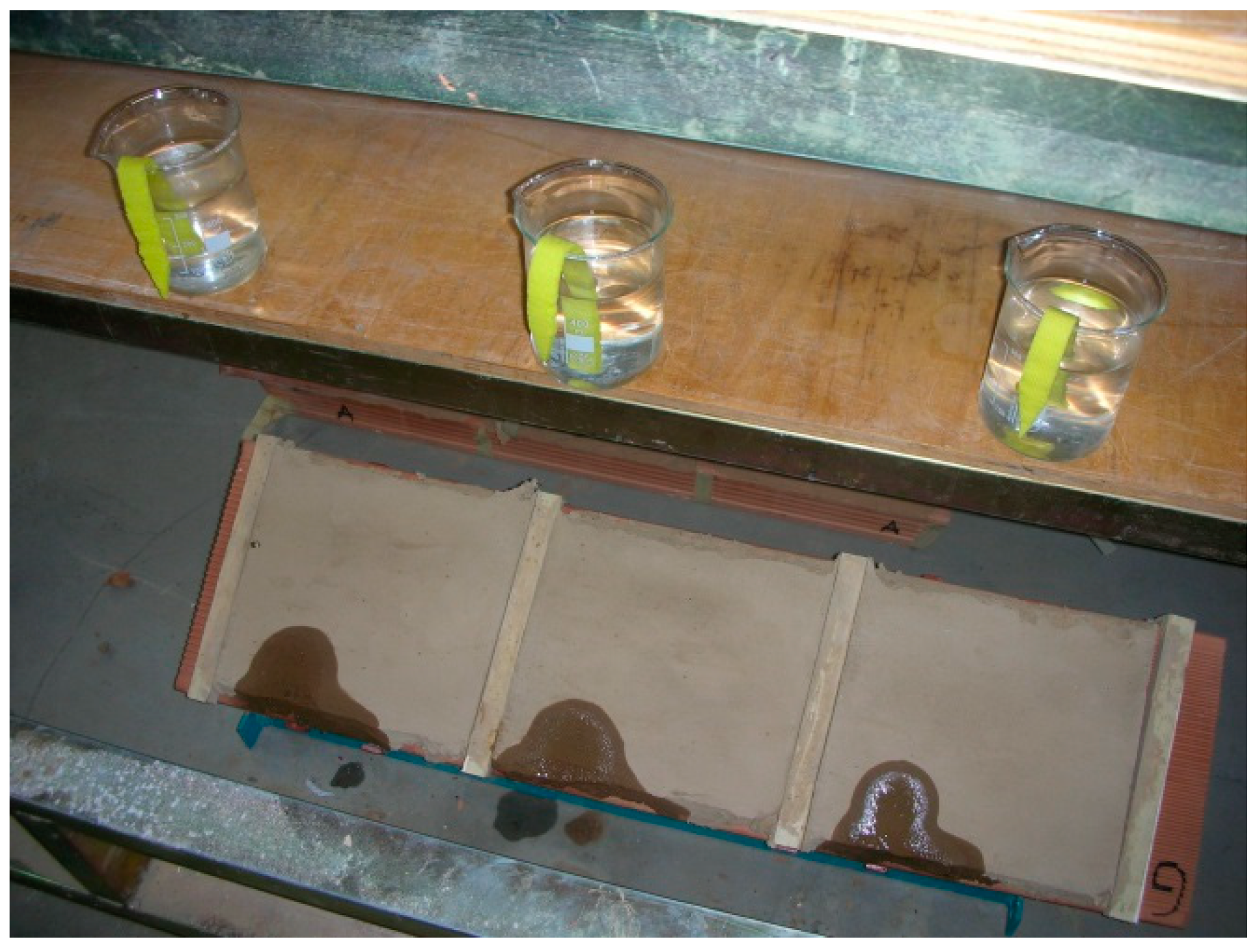
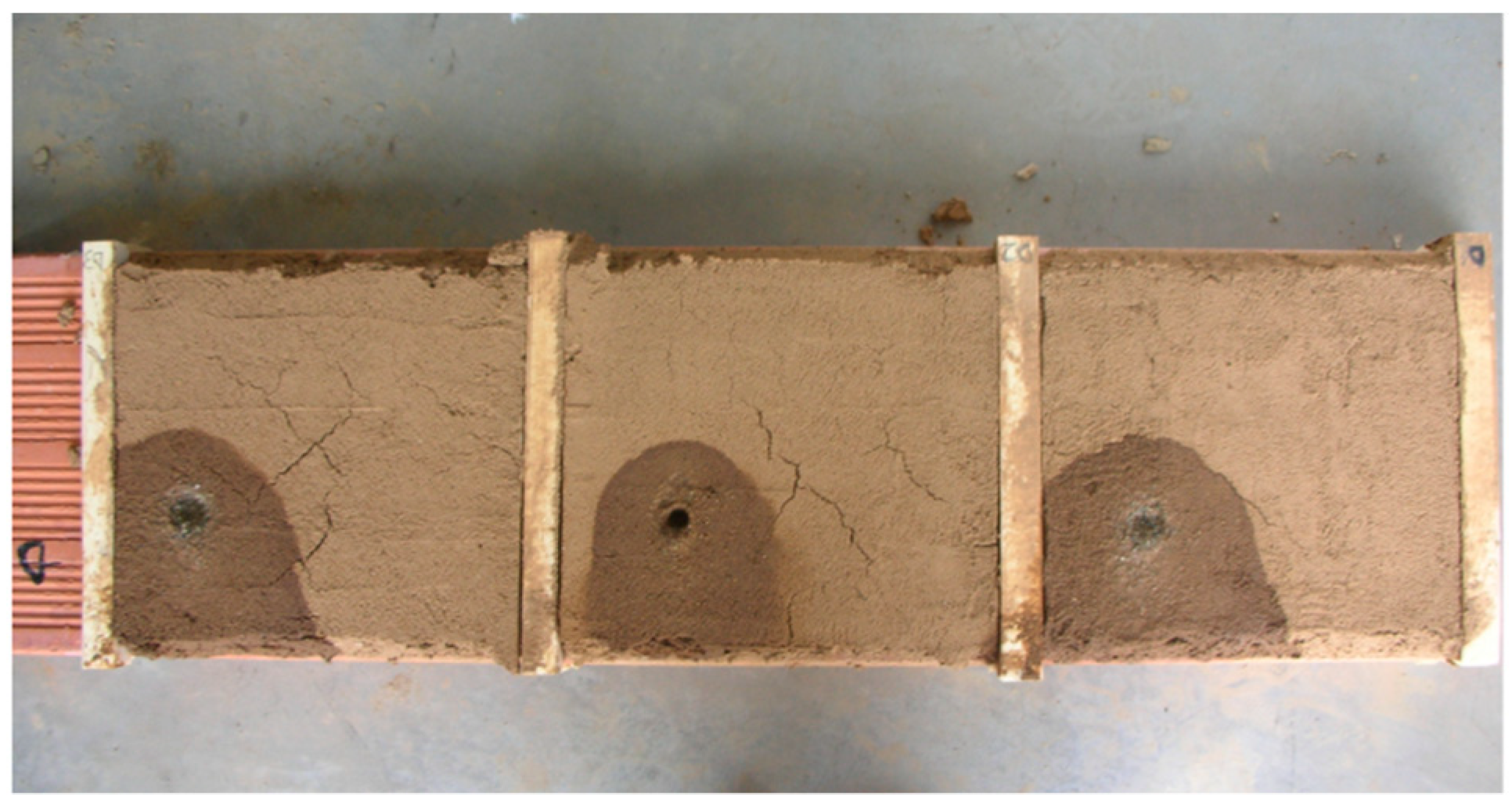
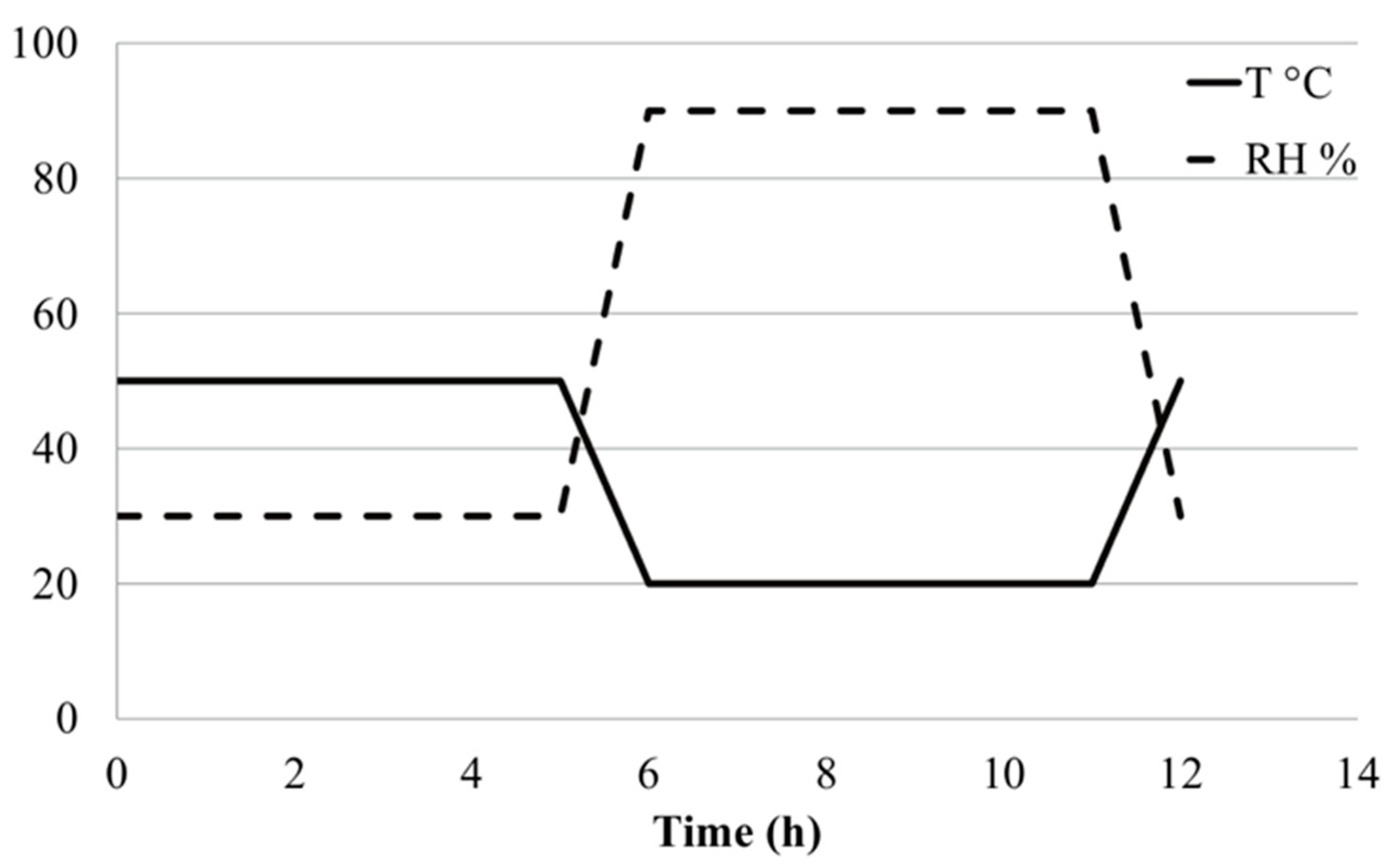
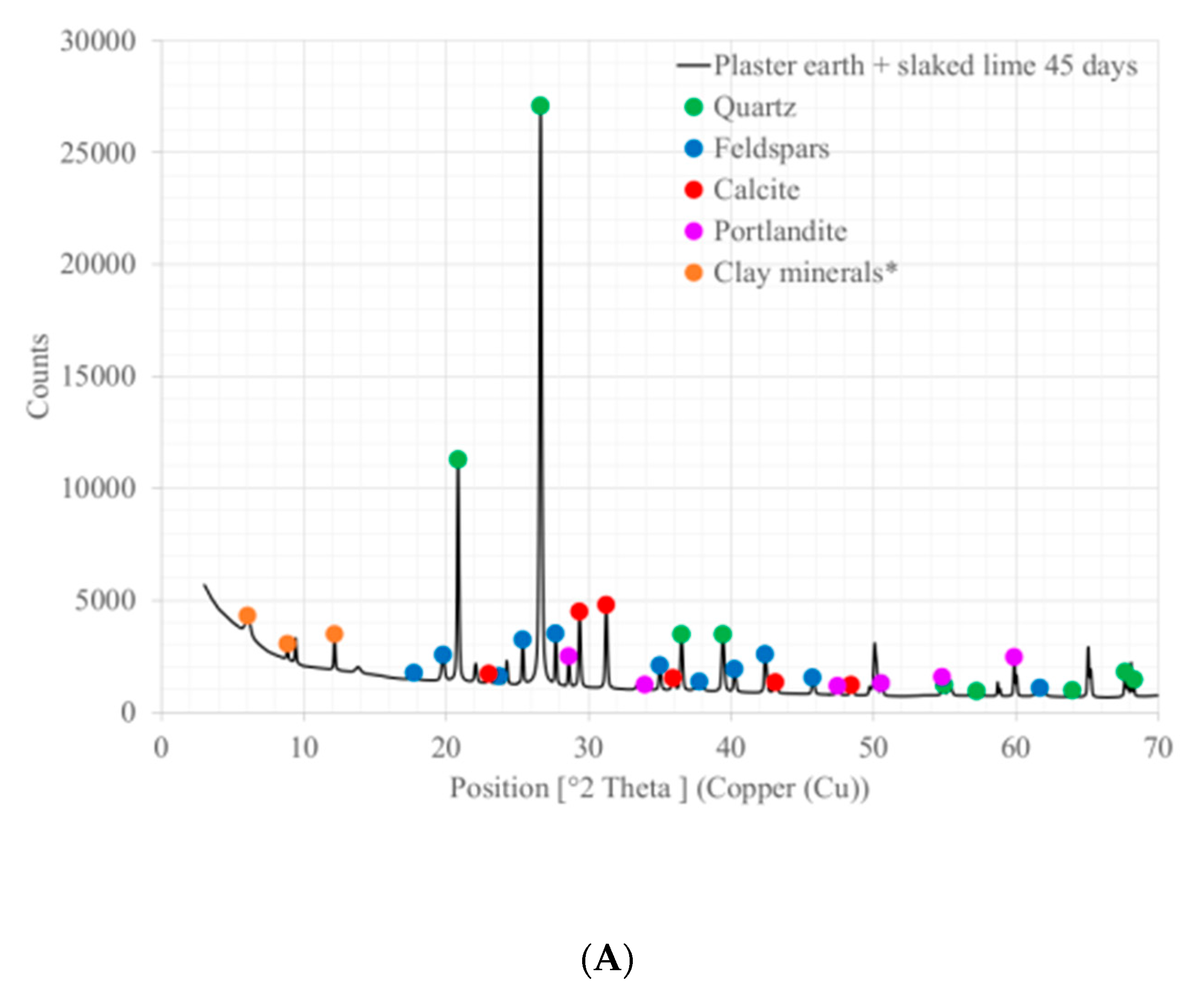
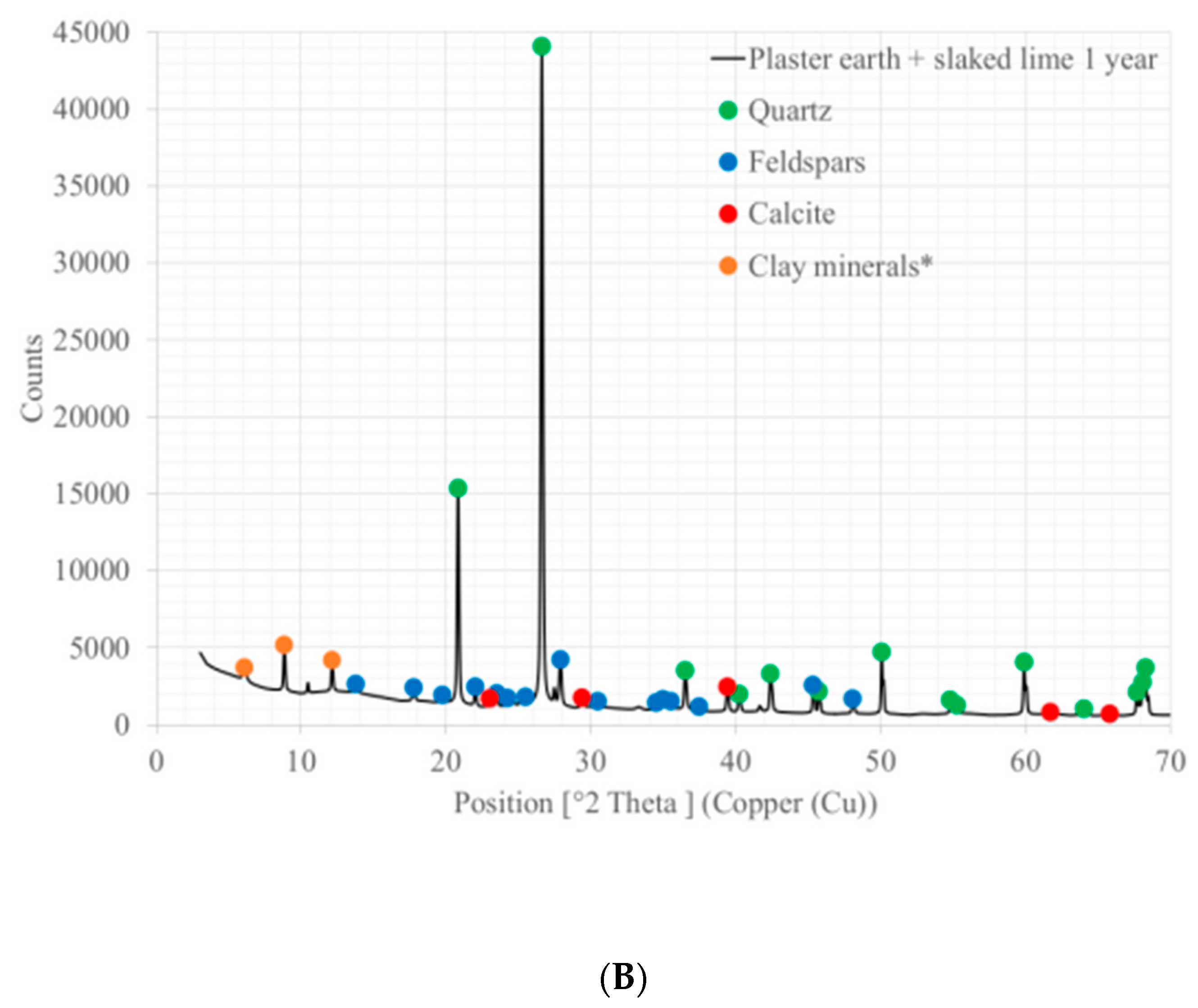
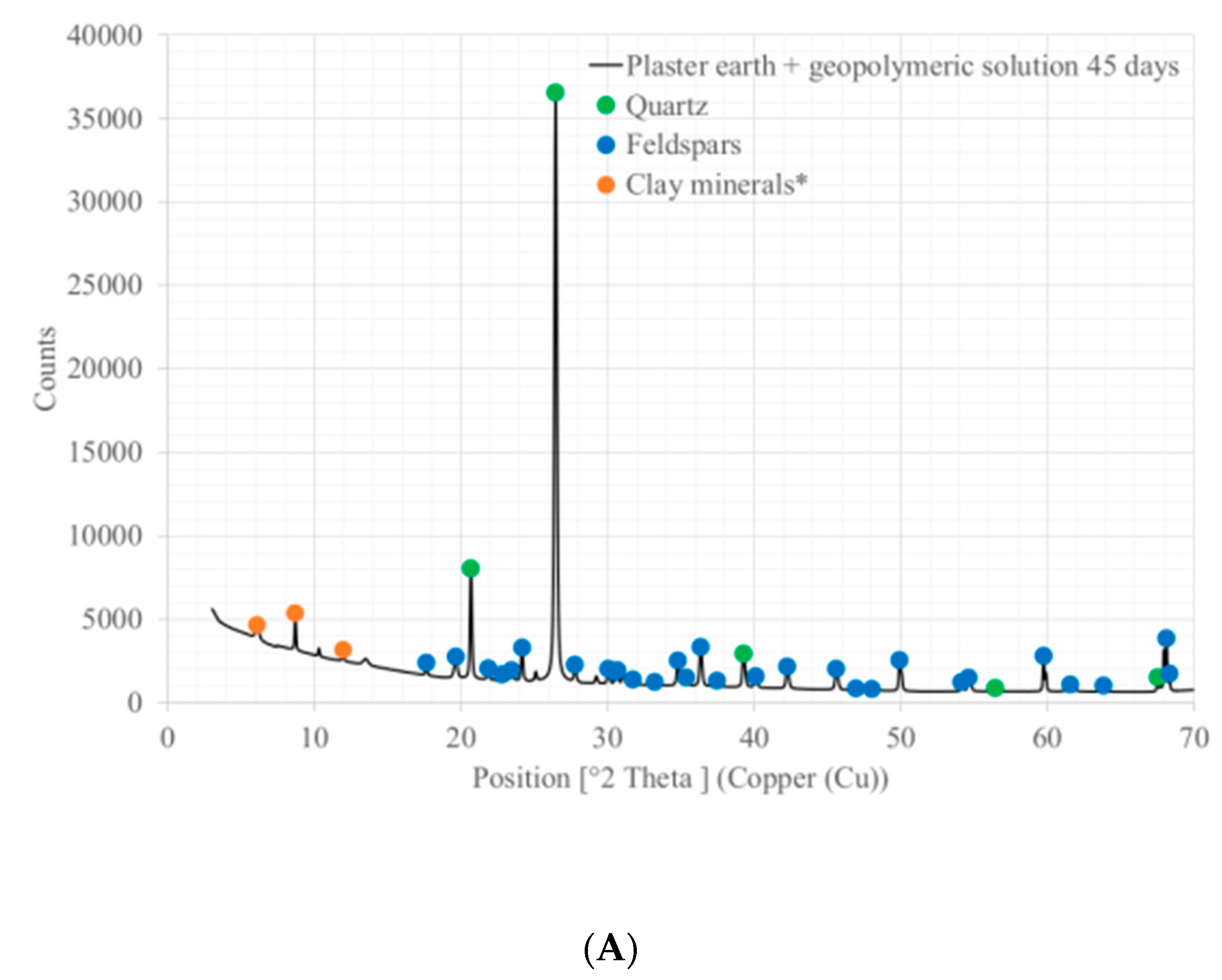

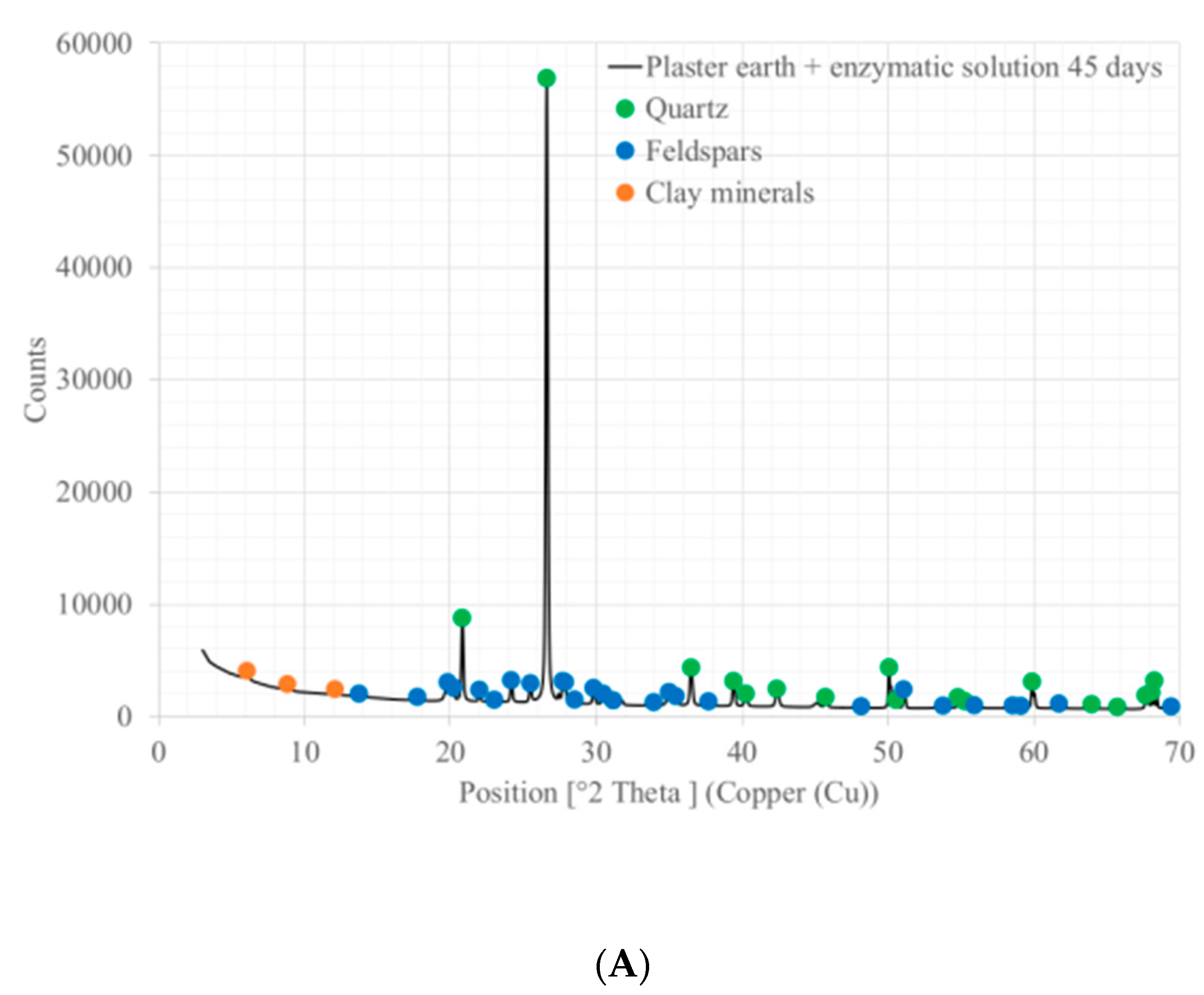
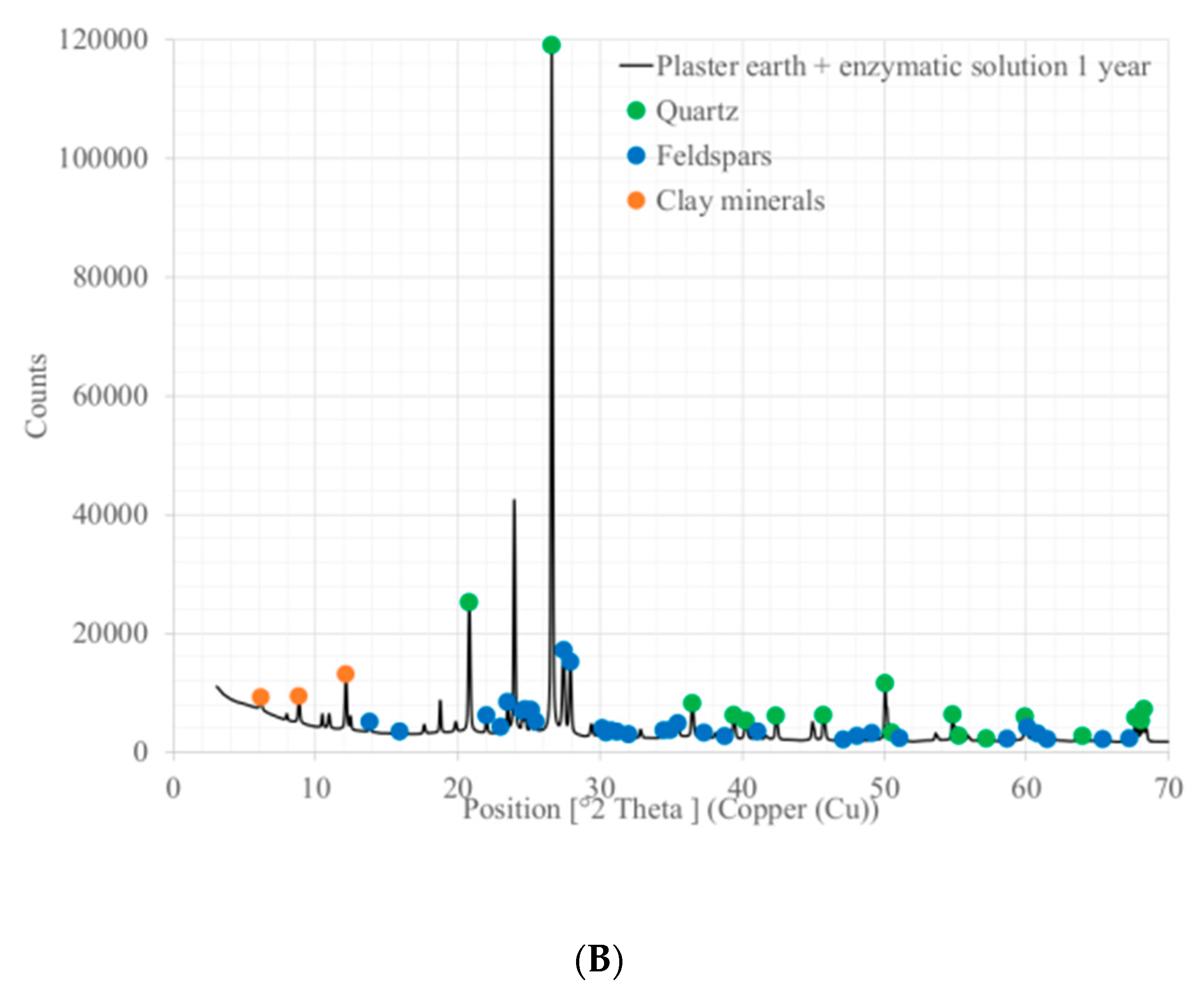
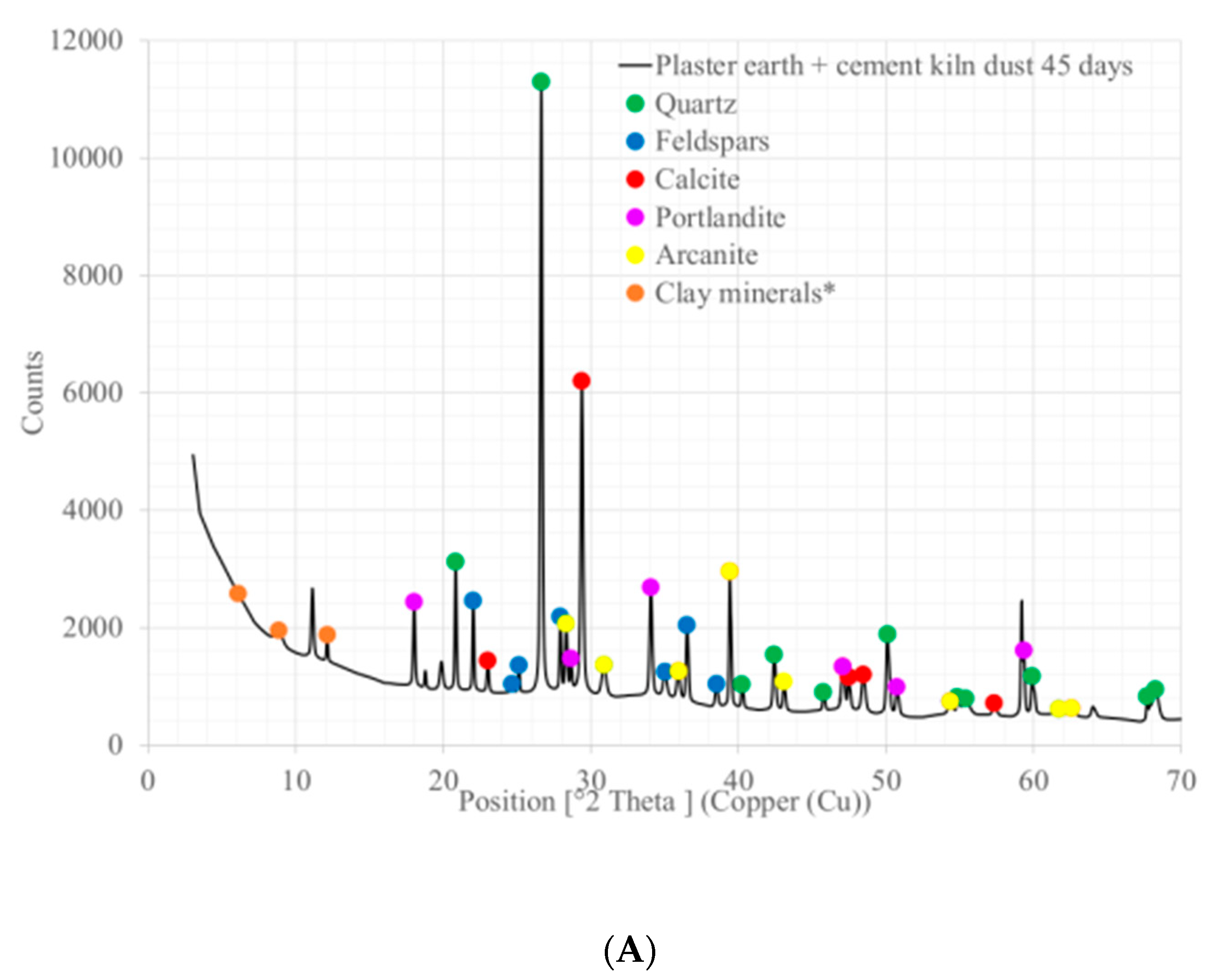
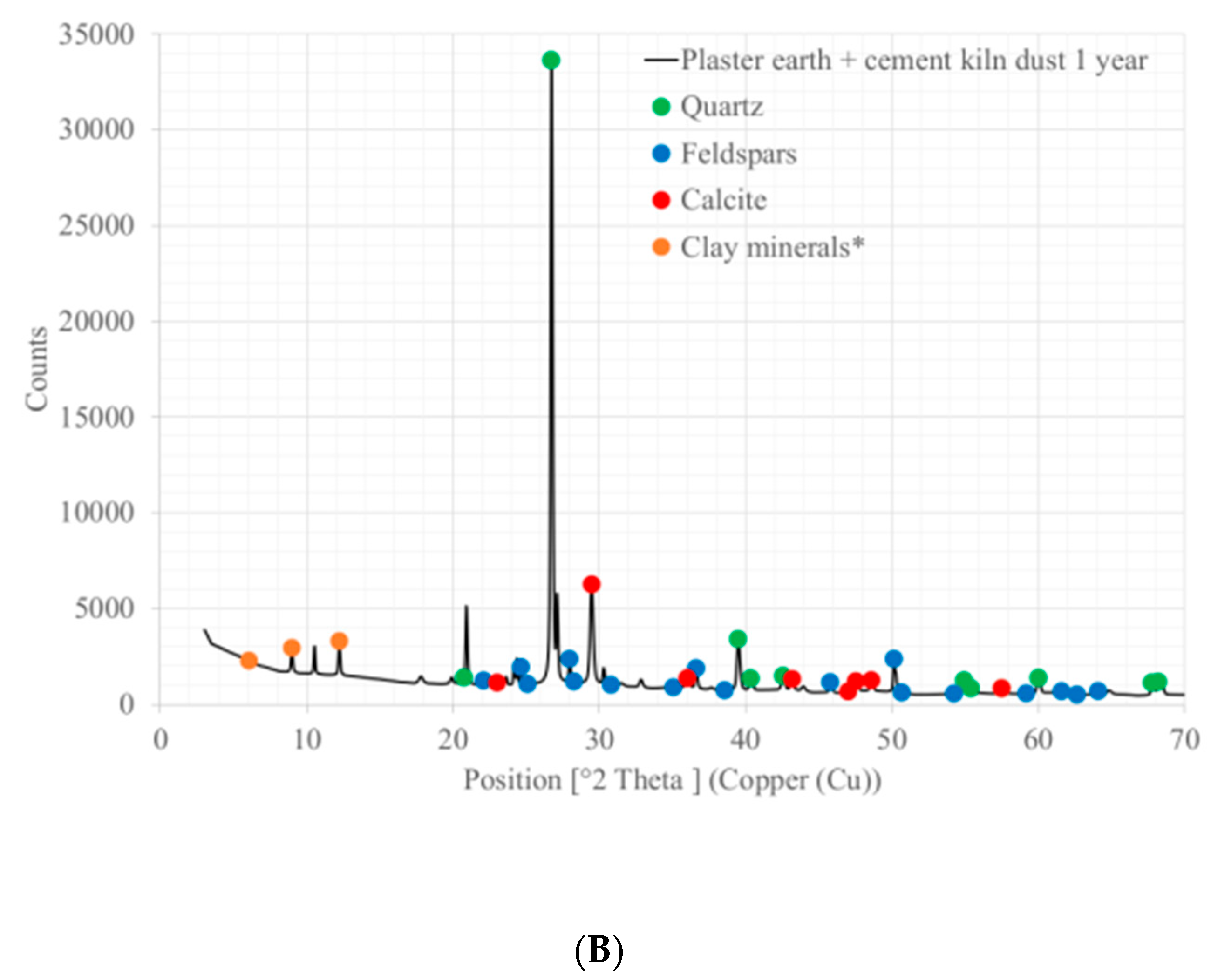
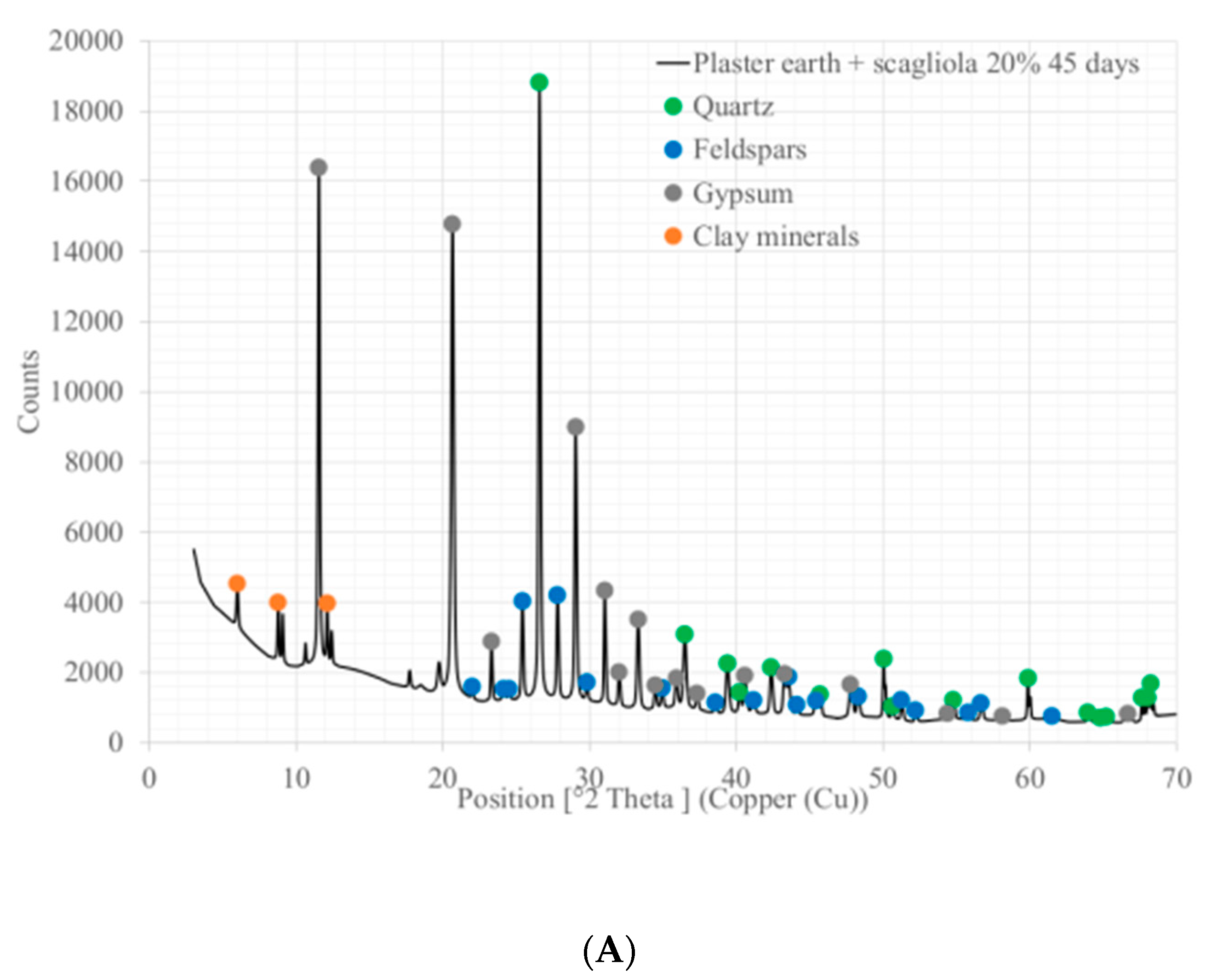
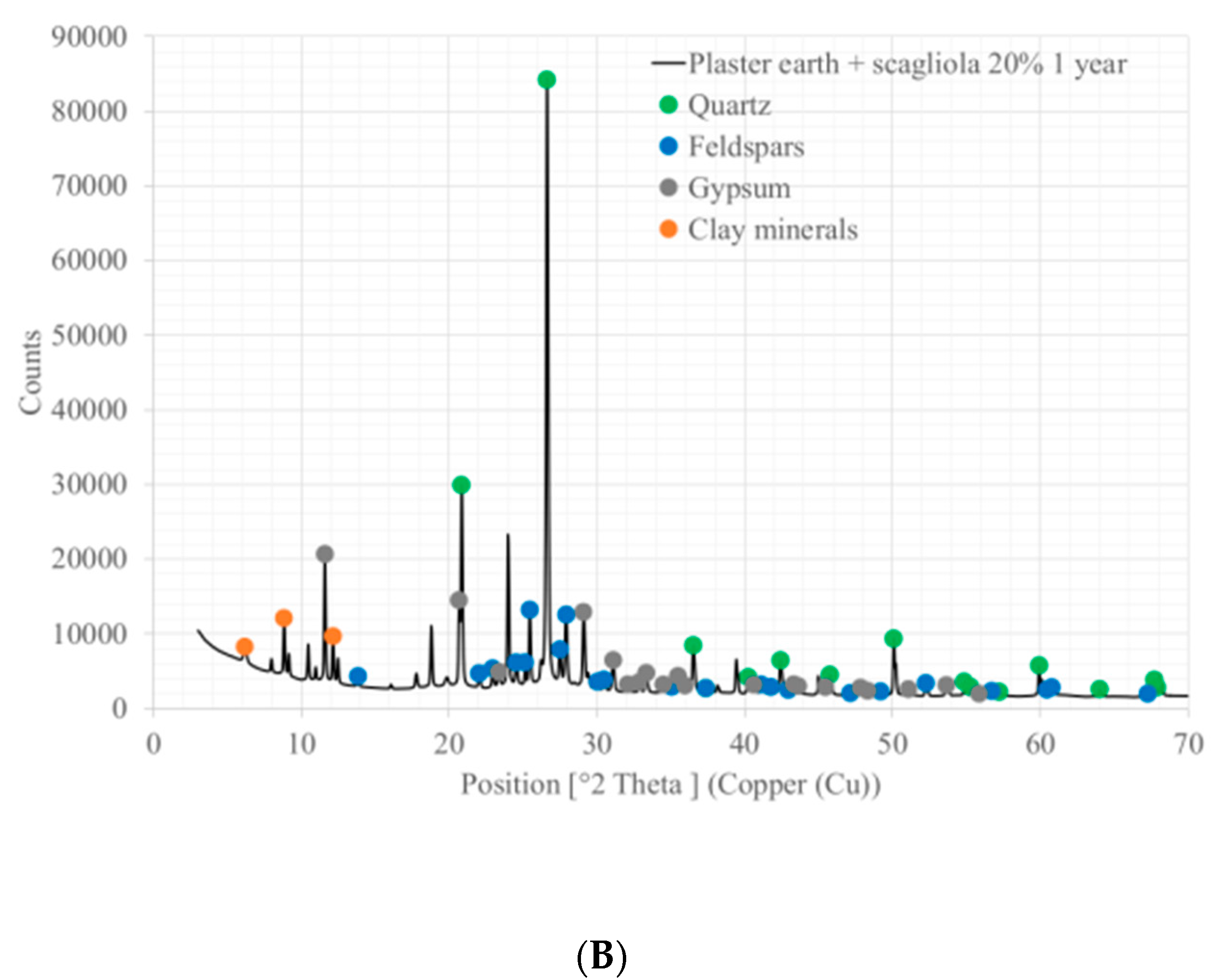
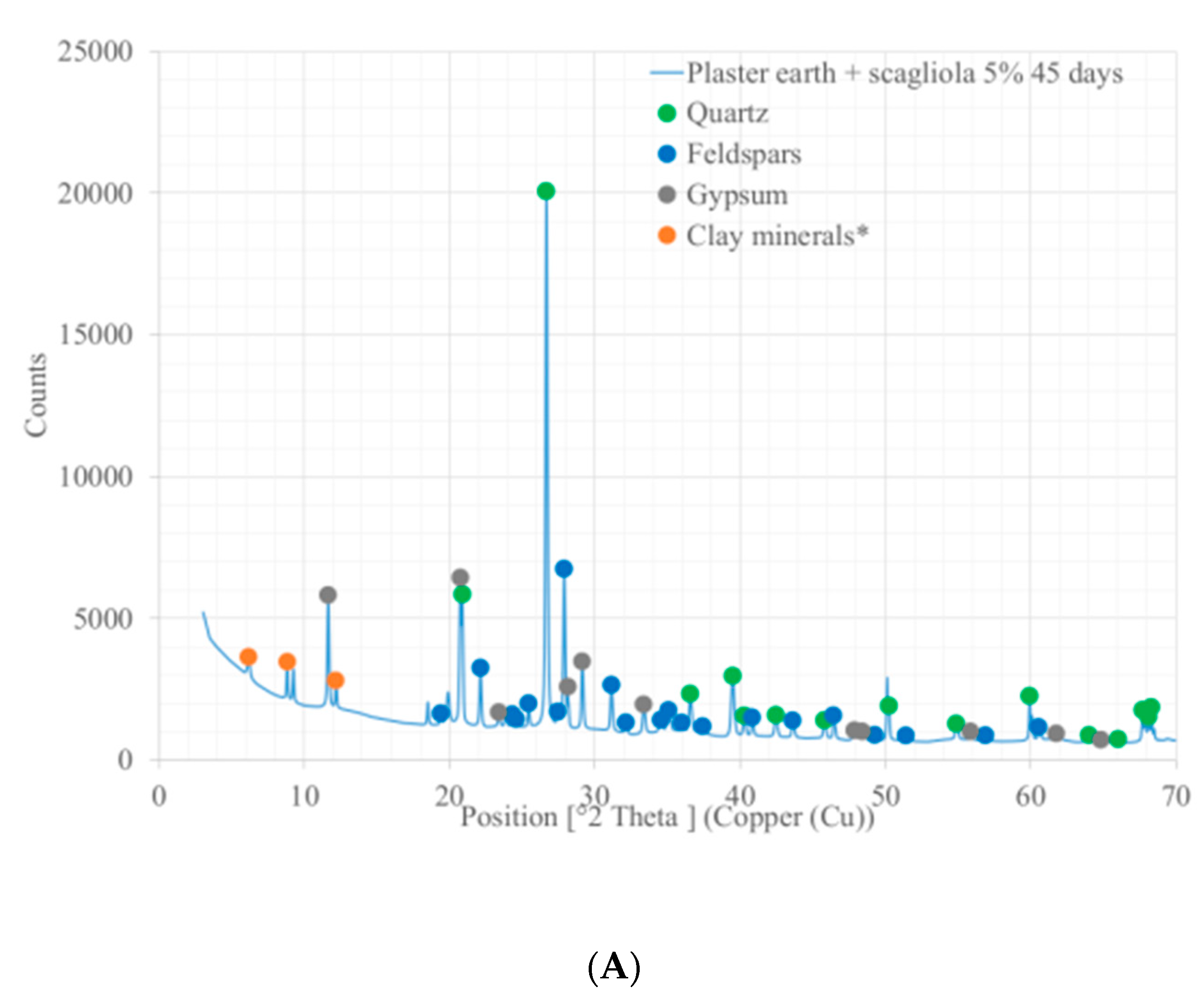
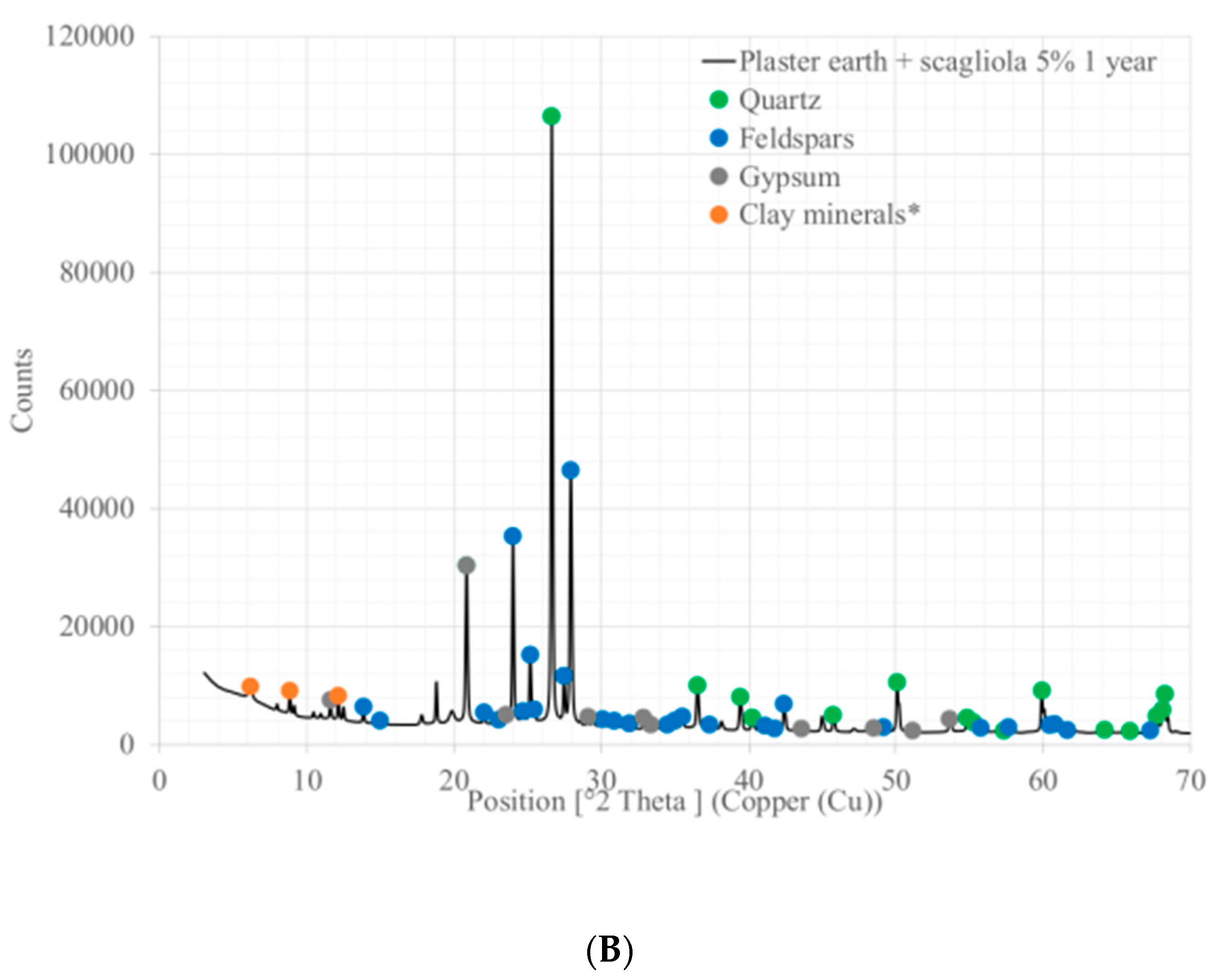
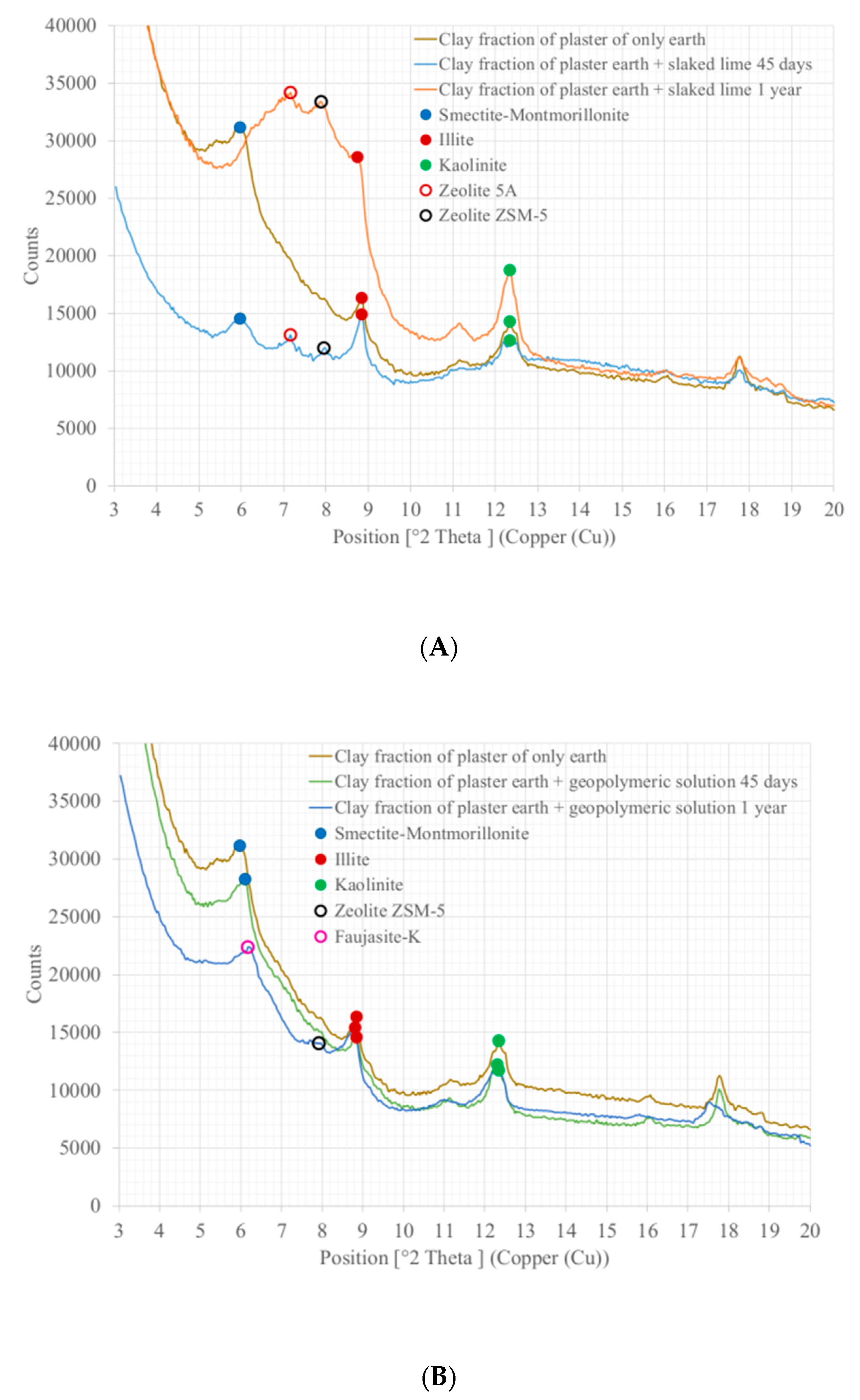
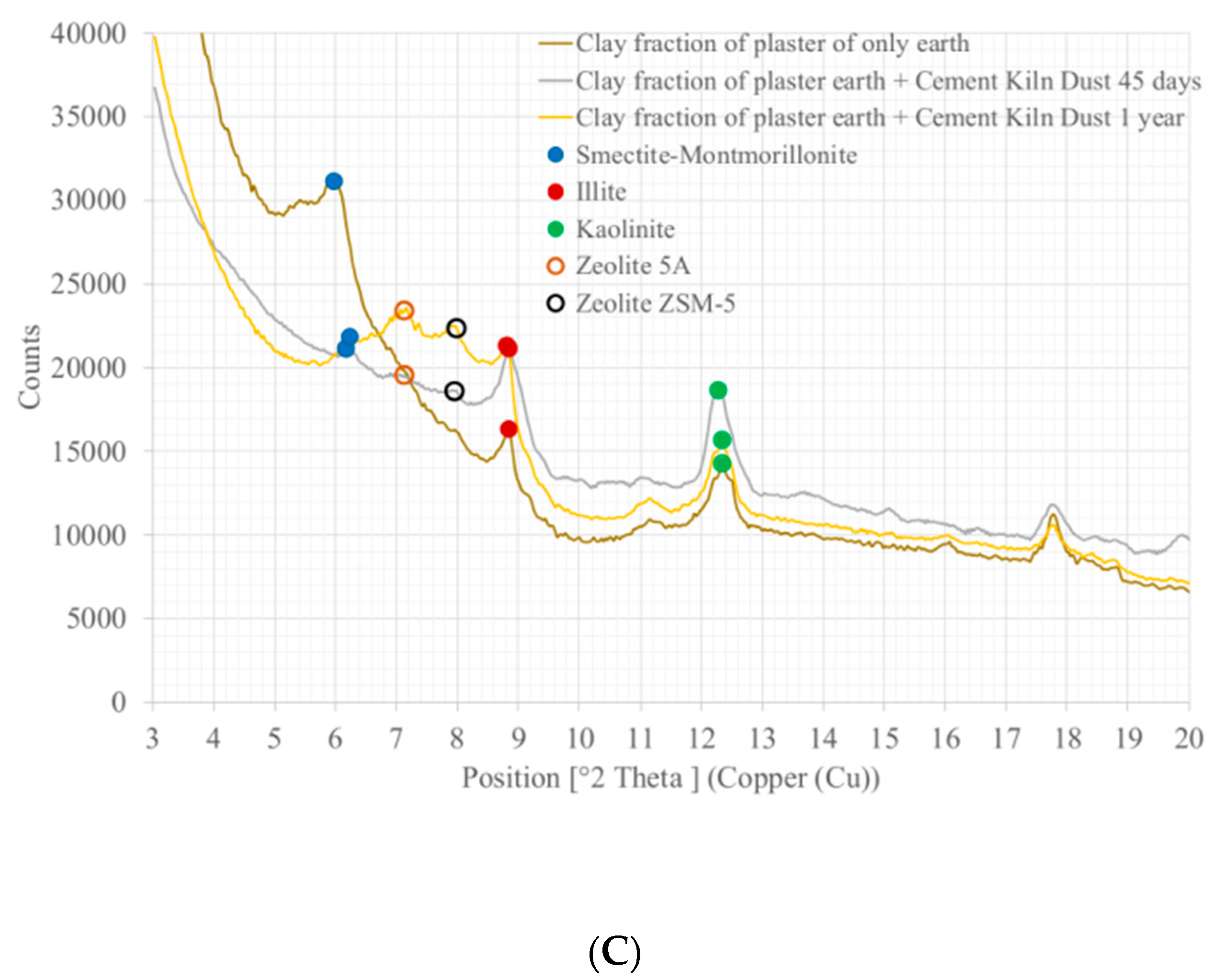
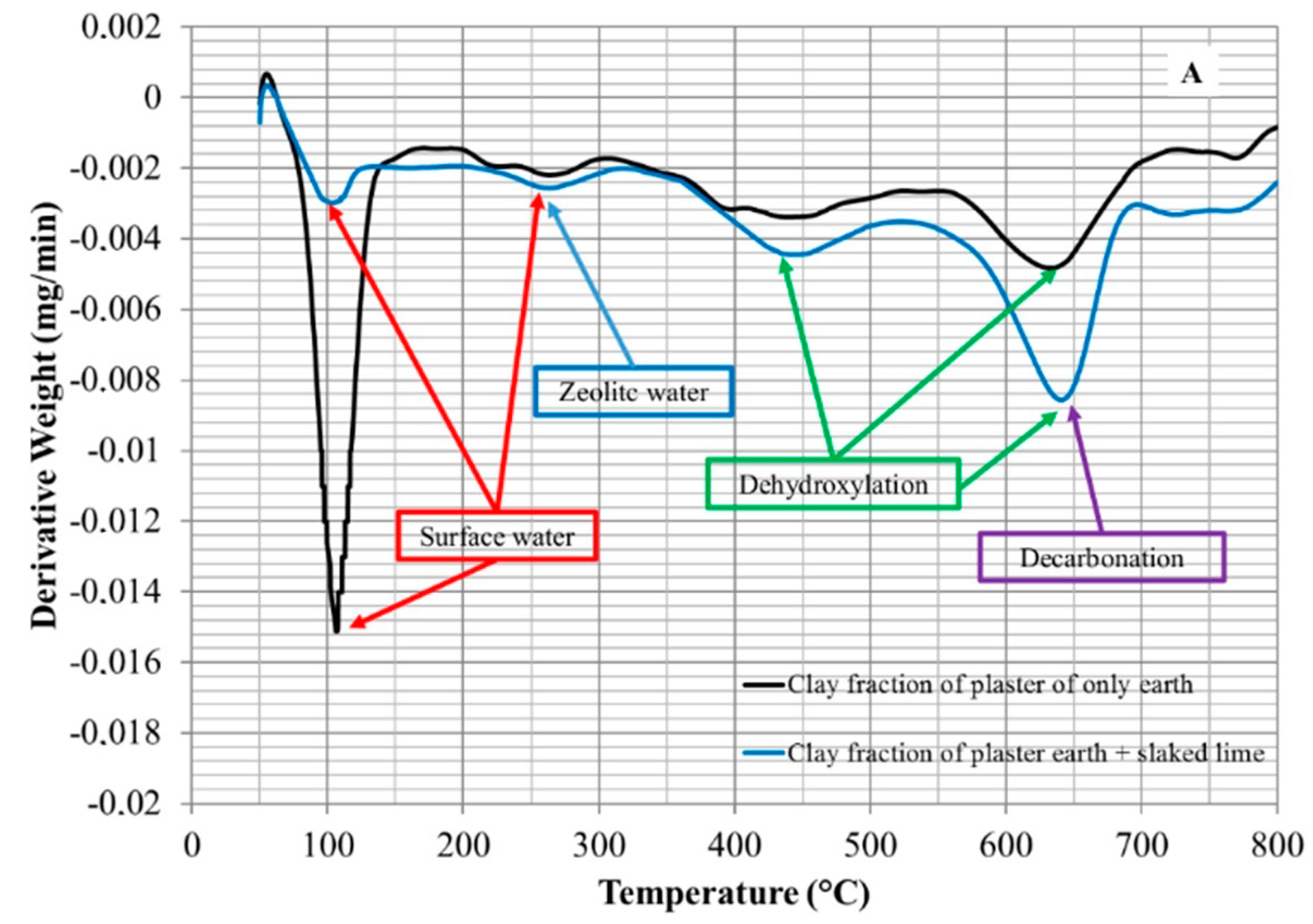
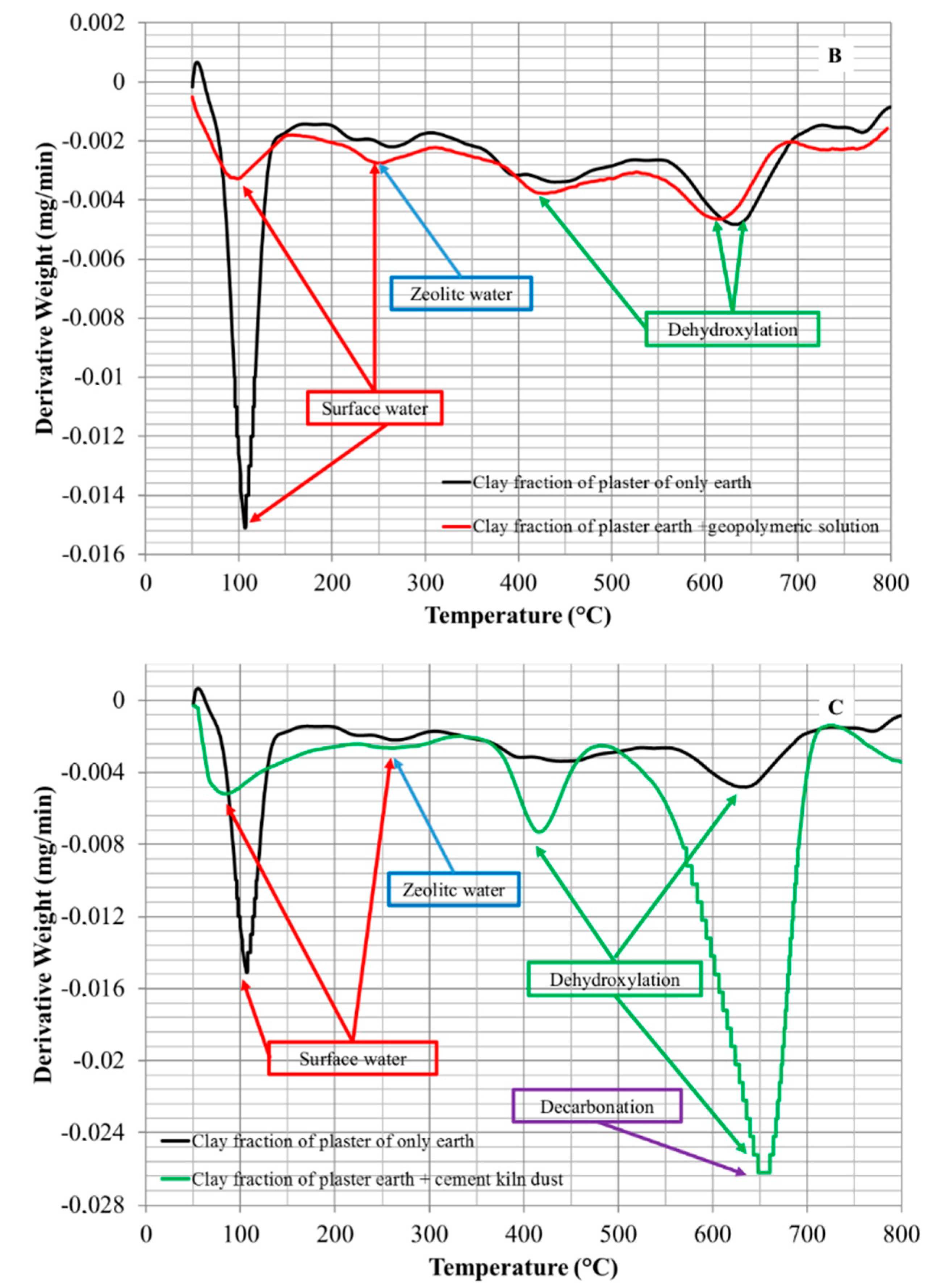

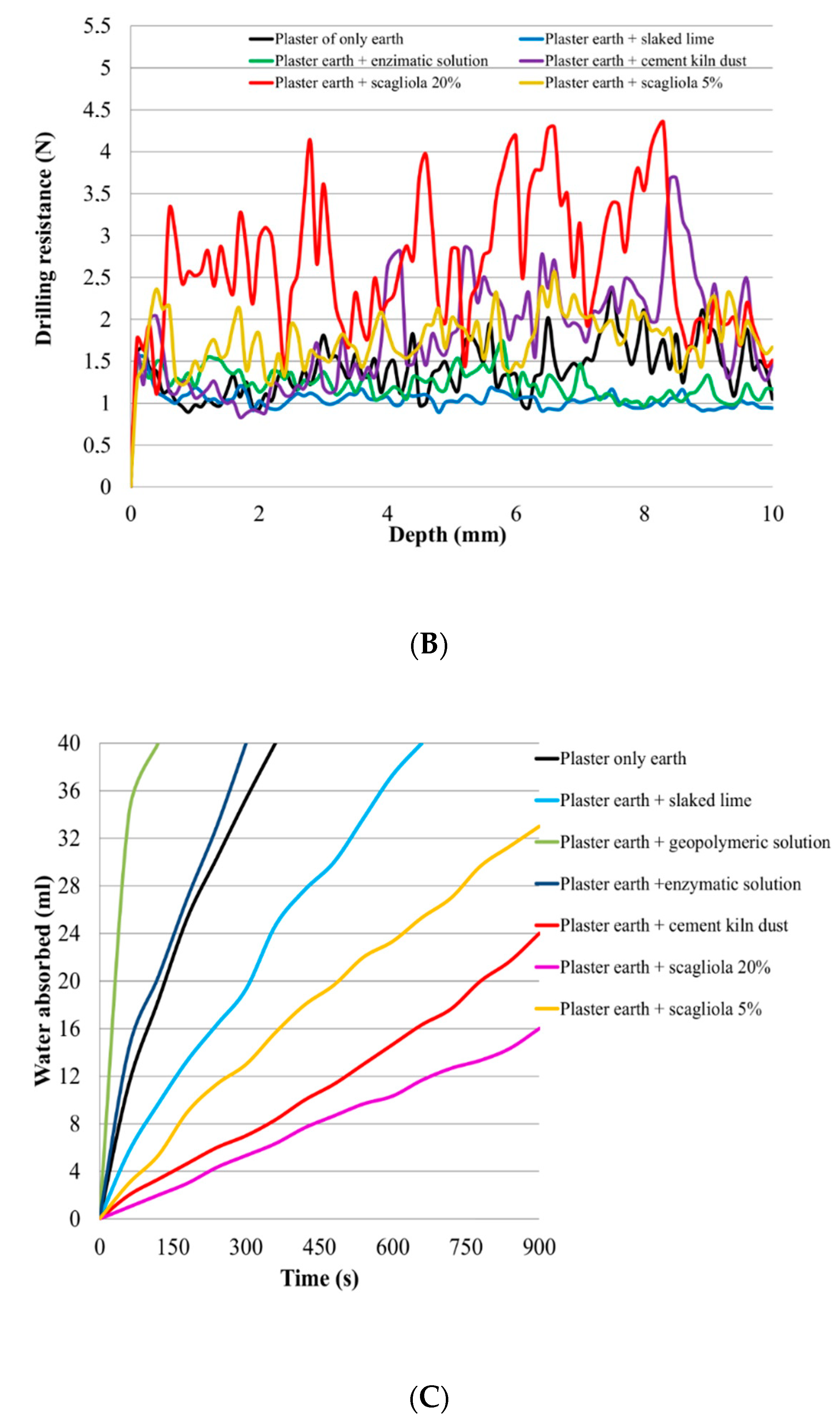
| Test | Sample Size (cm) | Samples for Each Plaster Mix | Tests for Each Sample | Total Number of Test for Each Plaster Mix |
|---|---|---|---|---|
| Water spray erosion | 25 × 25 × 2 | 3 | 1 | 3 |
| Water Geelong erosion | 25 × 25 × 2 | 3 | 3 | 9 |
| Water absorption | 25 × 25 × 2 | 3 | 3 | 9 |
| Color § | 5 × 5 × 2 | 9 | 3 | 27 |
| Water vapor permeability (two layers sample) | 5 × 5 × 2 | 3 | 1 | 3 |
| Water vapor permeability (one-layer sample: fine earth fraction Ø < 1 mm) | 5 × 5 × 2 | 3 | 1 | 3 |
| Water vapor permeability (one-layer sample: coarse earth fraction 1 mm < Ø < 2 mm) | 5 × 5 × 2 | 3 | 1 | 3 |
| Drilling resistance | 5 × 5 × 2 | 3 | 3 | 9 |
| Thermo-hygrometric cycles | 5 × 5 × 2 | 3 | 1 | 3 |
| Mineralogical Phases | Temperature Range (°C) | Reference | ||||||||||
|---|---|---|---|---|---|---|---|---|---|---|---|---|
| 50 | 100 | 200 | 250 | 350 | 400 | 450 | 600 | 700 | 750 | 800 | ||
| Motnmorillonite | Loss of surface water | Dehydroxylation | [88] | |||||||||
| Kaolinite | Loss of surface water | Dehydroxylation | [82,83,84] | |||||||||
| Illite | Loss of surface water | Dehydroxylation | [87,88] | |||||||||
| Zeolites | Loss of absorbed water inside zeolites (zeolitic water) | Dehydroxylation | Zeolite ZSM-5: [82,89] Zeolite 5A: [82,88] Faujasite K: [88] | |||||||||
| CSH | Dehydration | [85,86,90] | ||||||||||
| C-A-H and C-A-S-H | Dehydration | [79,80,90] | ||||||||||
| Portlandite | Dehydroxylation | [80,82,90] | ||||||||||
| Calcite | Decarbonation | [80,90] | ||||||||||
| Sample ID | Depth of the Hole (mm) | Erosion Index |
|---|---|---|
| Earth | 9.6 ± 0.2 | 3 |
| A | 3.6 ± 0.4 | 2 |
| B | 9.3 ± 0.6 | 3 |
| C | 10.3 ± 0.7 | 4 |
| D | 0 | 2 |
| E | 0 | 2 |
| F | 9.3 ± 0.7 | 3 |
| Sample ID | Drilling Resistance (N) | ||
|---|---|---|---|
| Depth Range (mm) 0–10 | Depth Range (mm) 0–2 | Depth Range (mm) 2–10 | |
| Earth | 1.40 ± 0.71 | 1.11 ± 0.37 | 1.47 ± 0.72 |
| A | 1.04 ± 0.24 | 1.08 ± 0.30 | 1.02 ± 0.19 |
| C | 1.22 ± 0.34 | 1.31 ± 0.34 | 1.20 ± 0.30 |
| D | 1.86 ± 1.28 | 1.45 ± 0.93 | 1.95 ± 1.30 |
| E | 2.66 ± 1.68 | 2.37 ± 0.76 | 2.74 ± 1.72 |
| F | 1.79 ± 0.80 | 1.75 ± 0.61 | 1.80 ± 0.77 |
| Sample ID | Two Layers Sample | Fine Layer Sample | Coarse Layer Sample | |||
|---|---|---|---|---|---|---|
| μ (-) | Δμ (%) | μ (-) | Δμ (%) | μ (-) | Δμ (%) | |
| Earth | 8.0 ± 0.2 | - | 8.2 ± 0.2 | - | 7.6 ± 0.1 | - |
| A | 8.6 ± 0.1 | 8.0 | 8.8 ± 0.2 | 8.0 | 8.2 ± 0.1 | 8.0 |
| B | 8.0 ± 0.1 | 0 | 8.1 ± 0.1 | 1.0 | 7.7 ± 0.1 | 2.0 |
| C | 8.8 ± 0.1 | 11.0 | 9.0 ± 0.2 | 11.0 | 8.4 ± 0.2 | 11.0 |
| D | 12.5 ± 0.2 | 57.0 | 12.8 ± 0.2 | 57.0 | 11.9 ± 0.2 | 57.0 |
| E | 9.2 ± 0.2 | 16.0 | 9.5 ± 0.1 | 16.0 | 8.8 ± 0.1 | 16.0 |
| F | 8.2 ± 0.1 | 3.0 | 8.4 ± 0.1 | 3.0 | 7.8 ± 0.2 | 3.0 |
| Sample ID | L* | a* | b* | ΔL* | Δa* | Δb* | ΔE* |
|---|---|---|---|---|---|---|---|
| Earth | 51.68 ± 0.36 | 8.04 ± 0.06 | 23.04 ± 0.17 | - | - | - | - |
| A | 72.70 ± 0.21 | 4.97 ± 0.04 | 19.89 ± 0.15 | 21.01 | −3.07 | −3.15 | 21.47 |
| B | 42.19 ± 4.01 | 5.89 ± 0.12 | 17.72 ± 0.98 | −9.49 | −2.16 | −5.32 | 11.09 |
| C | 48.37 ± 0.15 | 7.67 ± 0.02 | 21.78 ± 0.05 | −3.31 | −0.37 | −1.26 | 3.57 |
| D | 69.38 ± 3.27 | 5.13 ± 0.54 | 17.62 ± 0.60 | 17.69 | −2.91 | −5.42 | 18.73 |
| E | 64.97 ± 0.84 | 6.48 ± 0.22 | 21.35 ± 0.48 | 13.29 | −1.56 | −1.69 | 13.49 |
| F | 55.20 ± 0.59 | 7.64 ± 0.17 | 22.71 ± 0.26 | 3.51 | −0.40 | −0.33 | 3.55 |
| Sample ID | Colorimetric Measurements | Weight Measurements | |||
|---|---|---|---|---|---|
| ΔL* | Δ a* | Δ b* | Δ E* | # Weight Loss(%) | |
| Earth | 2.81 | −0.70 | −0.36 | 2.92 | 0.29 ± 0.10 |
| A | −1.82 | 0.47 | 0.32 | 1.91 | 0.30 ± 0.10 |
| B | 2.05 | 0.36 | 0.23 | 2.09 | 0.33 ± 0.10 |
| C | 3.78 | −0.08 | 1.21 | 3.97 | 0.20 ± 0.10 |
| D | 4.24 | 0.11 | 3.03 | 5.22 | 0.32 ± 0.10 |
| E | 3.79 | −0.30 | 0.39 | 3.82 | 0.24 ± 0.10 |
| F | 1.69 | −0.76 | −1.57 | 2.43 | 0.25 ± 0.10 |
Publisher’s Note: MDPI stays neutral with regard to jurisdictional claims in published maps and institutional affiliations. |
© 2021 by the authors. Licensee MDPI, Basel, Switzerland. This article is an open access article distributed under the terms and conditions of the Creative Commons Attribution (CC BY) license (http://creativecommons.org/licenses/by/4.0/).
Share and Cite
Rescic, S.; Mattone, M.; Fratini, F.; Luvidi, L. Earthen Plasters Stabilized through Sustainable Additives: An Experimental Campaign. Sustainability 2021, 13, 1090. https://doi.org/10.3390/su13031090
Rescic S, Mattone M, Fratini F, Luvidi L. Earthen Plasters Stabilized through Sustainable Additives: An Experimental Campaign. Sustainability. 2021; 13(3):1090. https://doi.org/10.3390/su13031090
Chicago/Turabian StyleRescic, Silvia, Manuela Mattone, Fabio Fratini, and Loredana Luvidi. 2021. "Earthen Plasters Stabilized through Sustainable Additives: An Experimental Campaign" Sustainability 13, no. 3: 1090. https://doi.org/10.3390/su13031090






